A FLEXIBLE APPROACH
TAKING A FRESH SPIN ON CONVENTIONAL CRUMB RUBBER
SAFETY ON THE BIG SCREEN
A short film competition is giving young filmmakers the opportunity to produce the next big road safety campaign


ROAD TO IMPROVEMENT
Behind the scenes of one of Melbourne’s largest road infrastructure projects

AUSTRALIA’S ONLY SPECIALIST ROAD MANAGEMENT, CONSTRUCTION AND CIVIL WORKS MAGAZINE MAY 2023 Official media partners of












COVER STORY
16 Fulton Hogan
A look inside Fulton Hogan’s innovative spin on traditional crumbed rubber asphalt.
ROADS REVIEW
20 This month, we asked industry decisionmakers, ‘What more can the industry be doing to ensure the safety of workers on infrastructure projects?’
SAFETY
22 Putting road safety on the big screen TAC’s short film competition is targeting road safety amongst young drivers.
24 Keeping a keen eye with AI New AI-enabled cameras are keeping drivers and other motorists on the road safe.
27 The median of excellence
Ingal Civil’s new innovation in back-to-back central road barriers.
30 Constant improvement
Coffey Testing has established national
PROJECT REPORT
33 The road to improvement
A look inside the Epping Road Upgrade in Melbourne’s north-east.
MACHINERY & EQUIPMENT
36 Keeping it mobile
How Topcoat Asphalt’s mobile asphalt plant is transforming the company’s capabilities and services.
39 Rolling out the upgrades
An insight into the versatile and growing popularity of CAT’s CB2.7 GC roller.
41 Empowering teams on the go Revizto’s new phone app is giving users access to BIM on the go.
42 Power for all sizes
Toshiba International Corporation’s SCiB rechargeable battery is built for infrastructure applications.
45 Rolling with innovation SANY continues to innovate, with its SW305K and SW405K wheeled loaders.
SUSTAINABILITY
46 Crushing for good Rokon’s rock crushing plant is delivering sustainable outcomes for projects across Victoria.
48 A hybrid of innovations
John Deere is achieving sustainable business outcomes by hybridising some of its traditional machines.
INSIDE CONSTRUCTION
50 A preview of the 2023 Inside Construction Expo.
AFPA SECTION
53 Transforming road safety
An overview of a new pilot program aimed at reducing speeding amongst motorists.
ISC SECTION
56 Supporting the next generation of leaders
The ISCouncil has developed a new program to develop the next generation of sustainable leaders.
CONTRACTS & TENDERS
58 A summary of the contracts awarded for major infrastructure projects across Australia.

REGULARS
4 Editor’s note
6 News
14 People on the move
The back-to-back guardrail, designed to absorb the energy and impact of cars hitting the barrier surface.
MAY 2023 CONTENTS
THE BRIGHT SIDE
WHETHER IT BE THROUGH changing risk-taking behaviour or embedding a safety culture, companies are doing their bit to ensure their workers can return home safely. Increasing risk mitigation and fostering a supportive environment for mental health are among the many strategies that companies now consider a priority. Which is why we are aiming to highlight the progress being made. In the May edition of Roads & Infrastructure , we take a look at how the industry is avoiding hazardous situations and environments through the use of technology and best practice.
The Transport Accident Commission (TAC) has become a pioneer of road safety awareness, thanks in part due to its iconic advertising campaigns dating back to the 80s. We put TAC’s Split Second Competition under the spotlight to learn how the program is helping increase road safety, while also launching the careers of young filmmakers. The competition allows young filmmakers between the ages of 1825 to produce a short-film highlighting the dangers surrounding drink driving and driving while fatigued. Roads & Infrastructure Magazine sits down with TAC’s senior management, the Victorian State Government and past winners to learn more. This month we also learn more about Coffey Testing’s services when it comes to low-level radiation detection. Coffey Testing has established programs that are being used nationwide to train personnel in the treatment and detection of radiative materials and surfaces. Brooke Scott, Coffey Testing Safety and Wellbeing Manager, says these risk assessment services are essential for ensuring the safety of s taff on site.
For this month’s cover story, we shine a light on Fulton Hogan’s national approach to sustainable road project delivery, through innovations in crumb rubber asphalt. The company’s desire for sustainable outcomes has helped to produce a new spin on the crumb rubber concept. Successful trials of the product have shown its potential for future use, with the development of ‘TyrePhalt’ likely to be used as a template for future innovation in the road construction space.
Finally, in the May edition of Roads & Infrastructure Magazine , we had the pleasure of talking to the Infrastructure Sustainability Council’s CEO to hear how the council is aiming to attract the next generation of industry leaders, through its ‘Rise’ Mentoring Program. The mentoring program has already attracted keen interest from some of the sector’s most renowned sustainable representatives.

Happy reading!
Tom O’Keane Roads & Infrastructure Magazine

COO
Christine Clancy christine.clancy@primecreative.com.au
GROUP MANAGING EDITOR
Sarah Baker sarah.baker@primecreative.com.au
MANAGING EDITOR
Mike Wheeler mike.wheeler@primecreative.com.au
EDITOR
Tom O’Keane tom.okeane@primecreative.com.au
JOURNALIST
Shannon Paten shannon.paten@primecreative.com.au
DESIGN PRODUCTION MANAGER
Michelle Weston michelle.weston@primecreative.com.au
ART DIRECTOR
Blake Storey
DESIGN
Bea Barthelson
BUSINESS DEVELOPMENT MANAGER
Brad Marshall brad.marshall@primecreative.com.au
CLIENT SUCCESS MANAGER
Glenn Delaney glenn.delaney@primecreative.com.au
HEAD OFFICE Prime Creative Pty Ltd 379 Docklands Drive, Docklands VIC 3008 Australia p: +61 3 9690 8766 f: +61 3 9682 0044 enquiries@primecreative.com.au www.roadsonline.com.au
SUBSCRIPTIONS +61 3 9690 8766 subscriptions@primecreative.com.au
Roads & Infrastructure Australia is available by subscription from the publisher. The rights of refusal are reserved by the publisher.

ARTICLES
All articles submitted for publication become the property of the publisher. The Editor reserves the right to adjust any article to conform with the magazine format.
COPYRIGHT
Roads & Infrastructure Australia is owned and published by Prime Creative Media. All material in Roads & Infrastructure Australia is copyright and no part may be reproduced or copied in any form or by any means (graphic, electronic or mechanical including information and retrieval systems) without the written permission of the publisher. The Editor welcomes contributions but reserves the right to accept or reject any material. While every effort has been made to ensure the accuracy of information, Prime Creative Media will not accept responsibility for errors or omissions or for any consequences arising from reliance on information published. The opinions expressed in Roads & Infrastructure Australia are not necessarily the opinions of, or endorsed by the publisher unless otherwise stated.
4 ROADS MAY 2023





EXPERTS IN MOBILE PLANT INSURANCE For more information on UAA’s Industrial Special Plant and Procon products, please contact your Insurance Broker or visit www.uaa.com Industrial Special Plant and ProCon underwritten by QBE Insurance (Australia) Limited. ABN 78 003 191 035, AFSL 239545. Underwriting Agencies of Australia Pty Ltd. ABN 86 003 565 302 AFS Licence 238517. Underwriting Agencies of New Zealand Limited (UAA). 4758199, NZBN: 9429040999678. J6663 Our insurance products are tailored to produce a hand crafted solution to meet your business needs The UAA Group has the knowledge, ability and capacity to insure a wide variety of plant and machinery spanning numerous industries. Our experienced claims team has access to a network of the very best expert industry repairers, assessors and suppliers. With over 30 years’ experience, UAA is the largest and most reputable specialist mobile plant and machinery insurer in Australia, New Zealand and globally.
CONSTRUCTION NOW UNDERWAY ON $2B COOMERA CONNECTOR

Construction works have now kicked off on the $2.16 billion Coomera Connector (Second M1), Queensland’s largest single road project. The works will see the development of the first stage of the 16-kilometre Coomera Connector, creating a ‘second M1’ to remove up to 60,000 local trips a day from the M1 Pacific Motorway.
The new road will be an alternative to the M1, providing more transport capacity to support the growing residential and business communities in the northern Gold Coast and neighbouring Logan areas. It will also mean more reliable travel times between Brisbane and the Gold Coast by alleviating congestion on the M1.
Early works to prepare for construction, between Shipper Drive, The final tracks have now been laid on the Metro Tunnel Project in Melbourne.
Coomera and Helensvale Road, have been ongoing since November 2021. The first stage of the project will be delivered in three construction packages: Stage One North: Shipper Drive, Coomera to Helensvale Road, Helensvale (now underway), Stage One Central: Helensvale Road, Helensvale to Smith Street Motorway, Molendinar (expected to start later this year) and Stage One South: Smith Street Motorway, Molendinar to Nerang-Broadbeach Road,
Nerang (in design).





A new, one-kilometre-long, Coomera River bridge crossing is a key feature of the first package, along with a fourmetre-wide shared active transport path. The Australian and Queensland governments have each committed $1.08 billion to the $2.16 billion to plan and build Coomera Connector Stage One between Coomera and Nerang. The Second M1 will open progressively from 2025.
FINAL TRACKS LAID ON METRO TUNNEL

The Metro Tunnel will create a new end-to-end rail line from Sunbury in the west to Cranbourne/Pakenham in the southeast, with bigger and better trains, next generation signalling technology
and five new stations in Arden Station, Parkville Station, State Library Station, Town Hall Station and Anzac Station.
Once complete, the Metro Tunnel Project will create capacity for more than half a million extra passengers each week during peak times and save
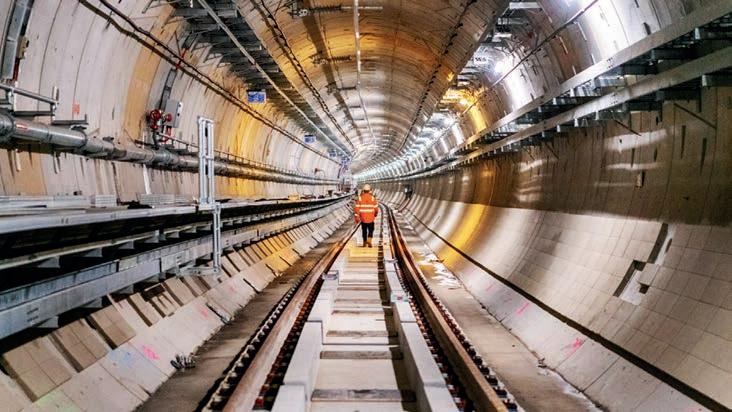
passengers in the suburbs up to 50 minutes a day on a return trip.
The final tracks being laid represents the culmination of nine months of work along the twin nine-kilometre tunnels and stations. These works began in mid-2022 with crews installing 4000 high-performance concrete panels to create an even base for the rail. The panels were cast in 300 different shapes to match the curvature and elevation of the tunnels.
Following the laying of the final tracks, crews are preparing for test trains which will begin running in the second half of 2023.
Additional works are still on-going to fit out the new five stations. This includes the installation of lifts, escalators, security systems, CCTV, passenger information displays and emergency phones.
The Metro Tunnel is expected to open in 2025.
6 ROADS MAY 2023
NEWS
Artist’s impression of Coomera Connector. Image courtesy of TMR Queensland.
The final tracks have been laid on the Metro Tunnel Project. Image courtesy of the Victoria’s Big Build.
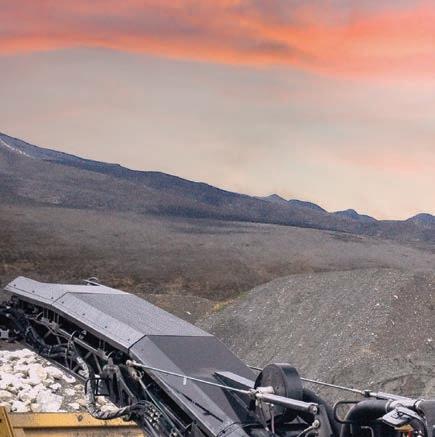




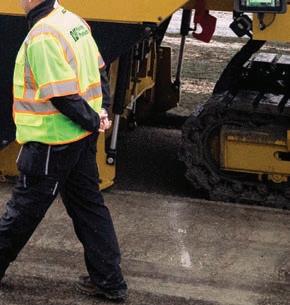































NEW VIC ELECTRIC VEHICLE LAB UNVEILED
The Victorian Government has unveiled a new purpose-built electric vehicle laboratory, which will aim to increase the skills and provide accreditation for emerging specialised technicians across the state.
The new laboratory, at the Kangan Institute’s Automotive Centre of Excellence at Docklands, will be home to new technology in electronic training boards and simulators, new computers and software programs and sophisticated teaching aids.
This equipment can simulate almost all variants of EVs, making it flexible and
adaptable to current and future markets. These facilities will improve the learning opportunities of new students and apprentices, while also upskilling existing industry technicians.
Kangan Institute will deliver a wide range of EV-specific accredited courses and skills to give those in the automotive industry the chance to upskill, including a new apprenticeship program specialising in EVs.
The new facility is set to support the Victorian Government’s target for EVs to make up 50 per cent of all new lightvehicle sales by 2030.

CONSTRUCTION BARGES IN PLACE FOR $786M BRIDGEWATER BRIDGE
The Bridgewater Bridge Project has reached a new milestone with the first construction barges now in place for the Tasmanian project.
The $786 million project is Tasmania’s largest ever transport infrastructure project and will aim to improve efficiency and safety, connect local communities and create more open space between the north and south of the state.
The new four-lane, one-kilometre-long

bridge will address the perceived missing link in Tasmania’s National Highway, improving connections at Bridgewater and Granton, as well as catering for cyclists and pedestrians with a safe shared path.

It will replace the existing 1940s era bridge, cutting travel times for the 22,000 motorists that use the route daily, and improving freight routes around Hobart.
Floated into place, linked together and rested on the riverbed, a total of 12 barges will provide a safe and sturdy temporary platform from which McConnell Dowell will construct the one-kilometre-long bridge.
This method aims to reduce costs and the environmental impact of constructing temporary work platforms. The new bridge will be open by the end of 2024.
8 ROADS MAY 2023
NEWS
An early impression of the Bridgewater Bridge Project in Tasmania. Image courtesy of the Tasmanian Government.
Photo by Waldemar Brandt on Unsplash.













Low carbon emissions polymer modified binders (PMBs) Puma Energy Bitumen 1800 24 88 66 bitumen.au@pumaenergy.com pumaenergy.com/en/web/bitumen/ Your journey towards net zero starts NOW with our next generation PMBs with biogenic component. Extract biogenic components Roads become perpetual CO2 vaults Integrated with our global supply network Trees capture atmospheric CO2 Puma CarbonBind
Introducing the first and only skid steer with a telescopic boom the JCB Teleskid; a truly unique, versatile skid steer with endless possibilities. Now you can lift higher, reach further, dig deeper.
This revolutionary product is designed to suit all types of job sites meeting the need of multiple machines wrapped nicely into one. Combining the strength and safety of our single side boom with side door entry and extendable boom JCB has increased the versatility of the SSL-CTL world.
To find out more contact your local JCB CEA dealer today. Ph: 1300 522 232 www.jcbcea.com.au



AUSTRALIAN FIRST FOR BURNLEY TUNNEL
An Australian-first pacemaker lighting system has been switched on for drivers in Melbourne’s Burnley Tunnel. Drivers in the tunnel will now see a green band of moving light along the

walls, which is expected to help keep pace through to the tunnel exit. These green bands will move at a speed safe and appropriate to traffic conditions in the tunnel with hopes
to encourage drivers to maintain a consistent speed, while never exceeding the tunnel’s speed limit of 80 kilometres per hour.
Due to the nature of the tunnel, drivers tend to slow down as they travel uphill to exit the tunnel.
The pacemaker lights are expected to prevent backlogs of traffic that can lead to congestion across the wider road network.
The installation of the new system was funded by Transurban. It included repainting the tunnel walls and installing new LEDs in an attempt to make the tunnel look brighter, more spacious and ultimately, safer.

A comprehensive road safety audit, which included closely examining the effect of pacemaker lighting on drivers, was completed as part of the project.
PLANS RELEASED FOR CANBERRA LIGHT RAIL
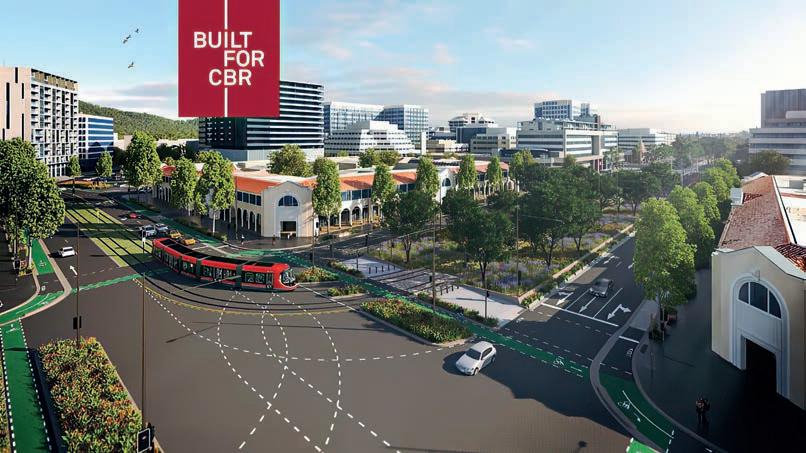
The final stages of planning for the Canberra Light Rail Project Stage 2A have been released with works approval and development application for the network now open for public comment. Stage 2A of the light rail is the first step in extending the network south to Woden. It is set to feature an additional 1.7 kilometres of wire-free track including three new stops at Edinburgh Avenue, City South and Commonwealth Park.
The final plans reveal details about the project design. These include a landscape developed with the National Capital Authority (NCA) to retain the historic character of Commonwealth Avenue, two new signalised intersections on London Circuit at West Row and University Avenue also providing pedestrian and cyclist crossings, and cycle ways on newly designed intersections at London Circuit and Northbourne Avenue.
Extra features of the plans also include in-ground pedestrian lights, a cobbled median on London Circuit West to
differentiate the light rail corridor from the roadway, grass track sections on parts of Northbourne Avenue, London Circuit and Commonwealth Avenue and a new inset bridge for the light rail constructed over Parkes Way, in between the two Commonwealth Avenue bridges.
Work is also currently underway to raise London Circuit, which will enable the construction of light rail stage 2A. Pending planning approvals and procurement processes, construction on the Stage 2A extension is expected to start soon after the raising of London Circuit is complete.
roadsonline.com.au 11
NEWS
Australian first technology is now being used on the Burnley Tunnel. Image courtesy of Roads Australia.
Final plans have been released for the Canberra Light Rail 2A Project. Image Courtesy of the ACT Government.
MAJOR MILESTONE FOR PERTH RAIL NETWORK
The biggest expansion of Perth’s rail network since the Mandurah line has hit a major milestone, with the first tracks being laid on the Metronet MorleyEllenbrook line.


The first section of rail will see approximately 1.5 kilometres of ballast and sleepers installed north of Whiteman Park Station through to the Gnangara Underpass and along Drumpellier Drive.
The project includes new stations at Morley, Noranda, Malaga, Whiteman Park and Ellenbrook, with patronage expected to reach 18,000 people boarding per day by 2031.
Specialised equipment has been used to undertake the 21 kilometre upgrade, including a ballast box spreader which positions the ballast and an excavator with an ‘octopus’ attachment to position the sleepers.

The $1.1 billion Metronet project is
the longest the company has seen and is jointly funded by the Federal and State governments.
The upgrade is expected to support the area’s growth as a major activity centre, while making the most of
development opportunities nearby, including new housing.
Set to be completed by late 2024, the project is expected to give locals greater transport choice, reduced travel times and new modern stations.
UGL COMPLETES MAJOR STAGE OF HUNTER POWER PROJECT
CIMIC’s UGL has completed concrete pours for a 3700-tonne concrete foundation, which forms part of the first gas turbine for the Hunter Power Project in New South Wales.

UGL is the principal contractor for the construction of the 660-megawatt power generation plant at the project in Kurri Kurri, commissioned by Snowy Hydro Limited.
The proposed Hunter Power Project at Kurri Kurri will fill the gap in electricity demand and ensure security of supply following the retirement of the Liddell Power Station in Muswellbrook.
The closure of Liddell Power Station will reduce NSW’s electricity supply by around 13 per cent and without replacement dispatch-able capacity, this risks prices rising by around 30 per cent over two years.
The Hunter Power Project comprises two open cycle gas turbines which will operate on natural gas and can also support hydrogen streams. Diesel is available on-site as a backup to support NSW’s power grid.
UGL’s concrete pour consisted of 1480 metres3 of concrete for the foundation of the first gas turbine. The final foundational
concrete block is over 3.5m high, 11m wide, and 36m long, and weighs approximately 3700 tonnes.
UGL’s entire scope of works includes procurement and supply of all the supporting components and auxiliary systems of a power plant needed to deliver the energy, all civil and foundation works, site installation of equipment supplied by both MHI and UGL, and testing and pre-commissioning.
By providing firmed energy the Hunter Power Project will facilitate an estimated 1.5 to 2GW of renewables, or the equivalent of 160,000 household solar installations.
12 ROADS MAY 2023 NEWS
Works continue on the Hunter Power Project.
Image courtesy of CIMIC ’s UGL.
First tracks have been laid on the Metronet MorleyEllenbrook line. Image Courtesy of Metronet Western Australia.

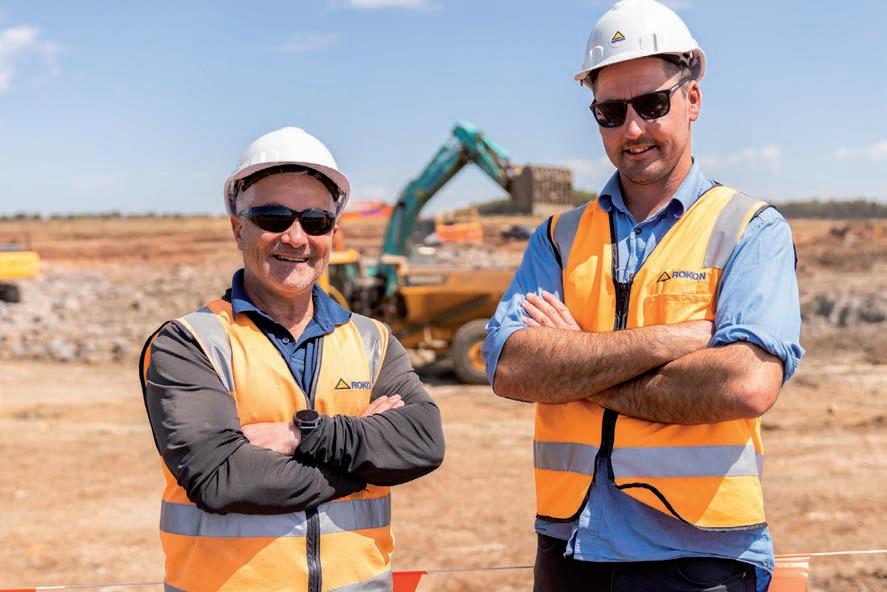


rokon.com.au MELBOURNE'S PREMIER CIVIL AND ROAD CONSTRUCTION COMPANY Residential Sub-Divisions Industrial Sub-Divisions Infrastructure & Structural works Medium Density / Retirement Developments Wetland Developments Rokon is certified for ISO 45001:2018; 14001:2015; 9001:2015 & OFSC Accredited
PEOPLE ON THE MOVE
ROADS & INFRASTRUCTURE HELPS YOU KEEP UP WITH THE LATEST MOVEMENTS ACROSS THE ROADS AND INFRASTRUCTURE SECTORS.
DOWNER APPOINTS NEW CHIEF FINANCIAL OFFICER



Downer has announced that Malcolm Ashcroft has been appointed as Chief Financial Officer, commencing in July 2023. Ashcroft is a leader with financial and senior executive experience in the infrastructure services, construction, health, and education sectors. Prior to becoming Chief Operating Officer (CEO) at G8 Education Limited (his current role), Ashcroft has held senior executive roles including as Chief Financial Officer at Healius Limited, Deputy Chief Financial Officer and Group Executive Transformation at CIMIC Group Limited, Acting Head of Finance and Risk at Sydney Metro and Senior Audit Partner at KPMG. He will take over from Michael Ferguson, who has held the position of CFO since October 2016.
Image courtesy of Financial Executives Institute.

LAING O’ROURKE APPOINTS NEW GROUP CHIEF OPERATING OFFICER
Laing O’Rourke has appointed Cathal O’Rourke to the newly created role of Group Chief Operating Officer (COO). The creation of the COO role will assist the Group and Europe executive teams to work closely together and share learning across the company’s international operations. He will begin his new role in April. During his time in Australia, he transitioned the business from an oil and gas resources focus to secure a broad pipeline of public infrastructure and defence work for the State and Federal Governments. As the Australian Managing Director and President of the Australian Constructors’ Association (ACA), he was important in the sector’s transition to more collaborative contracting, including early engagement models and incentives for high performance. Prior to leading the business in Australia, he had operational business unit leader roles in both Hubs, in main contracting and the specialist businesses. Cathal O’Rourke will support the recently updated business unit leadership team in Europe and be responsible for maximising the return of the company’s investments in strategic initiatives. He stepped down as Managing Director of the Australian business last year, after eight and a half years leading the hub and as a member of the Group Executive.
Image courtesy of Laing O’Rourke.
NEW CEO APPOINTED TO QRA
Major General Jake Ellwood (Rtd) has been appointed Chief Executive Officer (CEO) of the Queensland Reconstruction Authority (QRA). The QRA was established in 2010-2011 in response to the Queensland floods and Tropical Cyclone Yasi. It was made a permanent part of the Queensland Government in June 2015. Ellwood was originally State Recovery Coordinator for the 2022 South East Queensland flooding disaster, one of the biggest disasters to impact the state. He was national coordinator for the Australian Defence Force’s response to the Black Summer bushfires in 2019-20 and has served in Kosovo, Iraq, Afghanistan, and on two tours in East Timor. He served as Commander of the First Division, based in Brisbane, and as Deputy Chief of Army. Ellwood’s appointment comes after former QRA CEO Brendan Moon took on the role of Coordinator General of the National Emergency Management Agency (NEMA) in 2022. Major General Ellwood was appointed QRA CEO by an independent panel.
Image courtesy of the Queensland Government QRA.
14 ROADS MAY 2023
Introducing Ezy-Guard High Containment, a member of the next-generation Ezy-Guard barrier family, providing superior motorist safety. Ezy-Guard HC is proven and crash tested to the latest MASH Test Level 4 standard, distinguishing it from all existing public domain guardrail barrier systems in Australia.
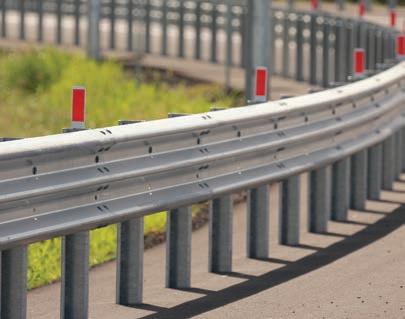
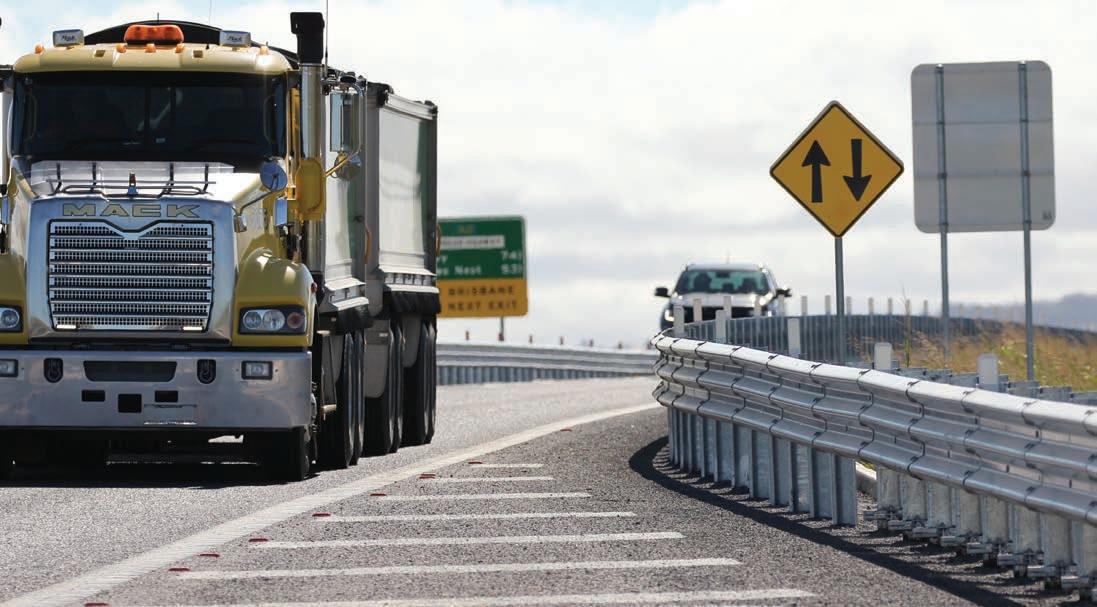
• Crash tested to MASH Test Level 4

10,000kg Truck
• Narrow footprint saving road width
• Easy to transport and simple to install
• Consideration for motorcyclists with rounded post corners
• Can be installed as a post-on-baseplate for areas where underground services restrict posts from being driven into the ground
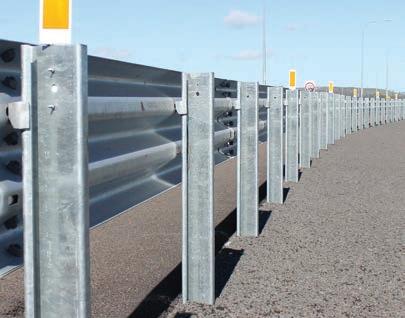
Ref: PP0615 www.ingalcivil.com.au sales@ingalcivil.com.au
• Sydney (02) 9827 3333 • Brisbane (07) 3489 9125 • Melbourne (03) 9358 4100 • Adelaide/NT 0438 153 482 • Perth (08) 9452 9111 • Newcastle 0400 235 883 • Wagga 0427 779 588 • Local call 1300 446 425 INGAL
High-Containment Roadside Safety Barrier
CIVIL PRODUCTS
Consideration for motorcyclists Narrow footprint saving road width Baseplated installation Australian Made MASH TL4 MASH TL3 MASH TL4: 10,000kg Truck + 2,270kg Utility
–
TL4 1.20m TL3 1.16m Ezy-Guard HC Deflections at 2m Post Spacing
A FLEXIBLE APPROACH
FULTON HOGAN IS PUSHING THE ENVELOPE WHEN IT COMES TO INCLUDING CRUMB RUBBER ASPHALT IN INFRASTRUCTURE PROJECTS OF VARYING SCALES NATIONALLY.

According to Tyre Stewardship Australia, 450,000 tonnes, or 56 million passenger tyres reach their end of life nationally, with some of these tyres often ending up in landfill.

Tyres can take centuries to decompose, meaning waste tyres pose a significant threat to the environment. This growing issue has resulted in tyres being listed as one of three priority waste streams by the Federal Government.
The use of recycled tyres in road construction has been a popular method internationally for decades, through the form of crumbed rubber asphalt and modified binders.
Crumbed rubber asphalt and binders feature varying percentages of tyre components, predominantly gathered from motor vehicles. The uses and variety of options for the market was previously limited. But thanks to collaboration and a push from both government and the private sector, including companies such as Fulton Hogan, has opened the door for a greater volume of crumb rubber asphalt use.
Fulton Hogan has more than three decades worth of experience in crumb rubber binder production, for both spray sealing and asphalt mixes.
Nick Canton, Regional Manager – Fulton Hogan Infrastructure Services - Southern
Region, says the company has vast experience in the development and utilisation of crumb rubber modified binders. He says this knowledge has led to additional research into new blend types.
“We’ve been using crumb rubber to modify spray seal binders for number of years,” he says. “In doing so, we identified the value in the modified properties, and how this could be adopted into asphalt.”
“We are continuing to innovate and explore solutions to our clients and communities’ waste and environmental problems. We are constantly exploring how we can use repurposed materials to increase specific performance characteristics across all our product range.”
Fulton Hogan has invested heavily to develop suitable infrastructure and established markets for the production of sustainable asphalts and spray seals across Australia.
In 2021-22 alone, Fulton Hogan manufactured over 16,000 tonnes of crumb rubber asphalt, helping to divert over 10,000 used tyres away from landfill. These crumb rubber modified asphalt products were used in road projects for most State Road authorities and many Councils including the City of Greater Geelong, Mornington Peninsula Shire, City of Greater Dandenong, City of Stonington, Central Coast, City of Lake Macquarie, Cessnock, City of Gold Coast and Moreton Bay Councils to name a few.
16 ROADS MAY 2023
Fulton Hogan’s wet blended crumb rubber asphalt is set to be used in a variety of road infrastructure projects.
Fulton Hogan has developed crumb rubber products for more than 30 years.
A NEW BLEND
Around 10 years ago, Fulton Hogan identified the opportunity to incorporate wet blended crumb rubber modified bitumen into asphalt.

Over the course of the last two years, development on these products have formed part of Fulton Hogan’s ‘TyrePhalt®’ banner, now a standard product in Fulton Hogan’s vast offerings in the crumb rubber binder and asphalt space.
Chris Lange, Technical Manager – Fulton Hogan Infrastructure Services - Northern Region, says the wet blend method can result in a product with vastly improved fatigue resistance properties.
“In the dry blend process, the crumbed rubber is added into a batch plant or the drum of a continuous mix to partially replace a portion of the fine aggregate. Whereas in the wet blend method the bitumen is modified by blending the crumbed rubber and bitumen in a specialised blending plant,” Lange says.
“The wet blend method enables quality assurance due to enabling the sampling of the resultant rubber modified binder and testing to ensure compliance to aspects like the softening point, viscosity and torsional recovery.”
In addition to reducing the number of tyres in landfill, wet blended crumb rubber asphalt can increase the fatigue resistance, binder viscosity, film thickness on aggregate and improved elastomeric properties.
Throughout the development of the wet blend asphalt, as well as TyrePhalt® products, Lange adds that Fulton Hogan received a greater level of knowledge on the properties and applicable materials for inclusion in production.

“We learned that the dense grade rubber modified asphalt is a better selection than currently used asphalt with Class or Multi Grade binder – due to its increased film thickness and binder content – resulting in better fatigue and durability properties,” he says.
Nick Canton says Fulton Hogan is always looking to incorporate repurposed materials such as RAP (Reclaimed Asphalt Pavement) and recycled glass sand to reduce the dependency on finite virgin quarried materials.
“We have completed projects where we have incorporated recycled glass, slag, RAP and tyre rubber whilst utilising warm mix technologies which in its own right can reduce our carbon intensity through energy use by up to 30 per cent,” Canton says.
“We have dedicated and accredited technical teams across Australia and New Zealand,
focusing on research and design who are constantly working with our clients to address emerging issues and problems.”
One such expert is Johannes van Heerden Technical Manager, Pavement and Materials Engineering – Fulton Hogan Infrastructure Services - Western Region.
“For the Australian market sustainability is a main focus in this point of time. It’s obviously extremely important. It’s also about performance,” van Heerden says.
“These products are more durable and are highly impermeable, because the more bitumen you put in there, the better the workability. The more impermeable the asset, the longer it’ll last. So these aspects are fantastic.”
van Heerden adds that these factors help to reduce the long-term costs for users.
“If you can actually increase your pavement structural depth, and the distribution of strains and stresses, which would be lower, you can improve the structural capacity as well. You can reduce rehabilitation or pavement
preservation treatment,” he says.
“Ultimately over a period of time this can reduce costs, not only for the cost of the product, but also the cost of the contract.”
PAVEMENT IN PARTNERSHIP
One of the major benefactors of the use and development of wet blended crumb rubber was Tyre Stewardship Australia (TSA), who provided financial support in the form of infrastructure grants.
“These grants have enabled the investment into and development of two Fulton Hogan PMB blending facilities in Australia that would not have gone ahead otherwise,” Canton says.
“Having this infrastructure ensures we are able to produce these products locally and deliver high performing products to the local community. It also helps to ensure an additional avenue for an end-of-life use for recycled tyres in these areas.”
Grants and guidance from Austroads, the Department of State Growth, TSA and the Australian Flexible Pavement Association have
roadsonline.com.au 17 COVER STORY
“WE LEARNED THAT THE DENSE GRADE RUBBER MODIFIED ASPHALT IS A BETTER SELECTION THAN CURRENTLY USED ASPHALT WITH CLASS OR MULTI GRADE BINDER – DUE TO ITS INCREASED FILM THICKNESS AND BINDER CONTENT – RESULTING IN BETTER FATIGUE AND DURABILITY PROPERTIES.”
Community and collaboration were important considerations for Fulton Hogan and the development of its crumb rubber asphalt.
helped to establish product trials in Tasmania to evaluate the performance of the binder against conventional materials.
Chris Lange says these types of trials aimed to provide an insight into the performance of the product in primarily LGA roads, environments with reduced traffic flows and associated pressures than metropolitan highways.
“The main purpose was to give local councils an opportunity to assess the products which are known to provide longer lasting, more durable and fatigue resistant road surfaces,” Lange says.

“These projects will also give the road asset owners experience and knowledge to assist them with developing specifications to utilise this product into the future.”

Lange hails the trials as a success, saying the performance exemplified the wet blend’s ability to extend the life of the pavement layer.
“The increased viscosity enables greater film thicknesses and binder content to be achieved in the various mix types where it is incorporated. This increases the product durability and ability to withstand stressed imposed on the product due traffic and pavement movement,” Lange says.
“It significantly reduces the thickness of the

treatment to avoid reflective cracking – thus providing a substantial cost saving.”
COMMUNITY AND COLLABORATION
On top of significant sustainability and performance benefits, the use and production of Fulton Hogan’s crumb rubber asphalt can also provide a boost for the local economy as well.

Nick Canton says Fulton Hogan carefully considers the wants and desires of the local communities in which we operate. No matter the context or size of the work at hand.
“When we look at things like sustainability, the local component and ensuring we do things right the first time cannot be over looked. Not only working with those local clients individually, but collaborating with local businesses. This is about making sure that we›re using local repurposed waste materials wherever possible and for that specific community, driving real value through sharing our technical support and knowledge,” Canton says. “There’s a heck of lot of work that goes into that.”
“We as contractors have an immense part to play in ensuring the most sustainable future for generations to come. This has to be achieved by people and through collaborative partnerships.”
“It›s going to be a combination of step change and incremental enhancements to get us to where need to be. We also need to enable our clients to realise shared value of these initiatives. We as contractors need to consider ourselves custodians of these assets and endeavour to leave them in a better condition than how we find them whilst extending their life cycles, it›s not just about a win for today, it’s about the longer term. Ensuring we take the right approach and contribute collectively to these environmental challenges”
Canton says the realisation and confirmation of crumb rubber asphalt’s benefits has led to an increased demand.
“The product has been adopted and approved by most State Road Authorities including TMR, DTP, Mainroads, TfNSW and DSG. We’ve also seen wider adoption by Local Government Authorities also,” he says.
He adds that the industry should “watch this space”, with further developments and improvements in discussion for the wet blended crumb rubber asphalt, as well as a slate of upcoming projects which will see the use of the material.

“Our clients have differing needs, our communities have unique environmental issues we need to help in resolving where we can. We understand there is no single product to solve all problems and are continuing to alter and fine tune our products and services,” Canton says.
“We also understand this is just the tip of the iceberg and we’ll keep challenging ourselves to strive for continuous improvement. It’s part and parcel of what we do.”
18 ROADS MAY 2023 COVER STORY
Fulton Hogan’s wet blended crumb rubber asphalt incorporates end of life tyres from a variety of sources, including motor vehicles.
On-going trials are evaluating the performance of wet blended crumb rubber asphalt.
Dedicated national NATA accredited labs, as well as Australasian Technical and Research and Design teams helped to develop wet blended crumb rubber asphalt.




MOVING TOMORROW, TODAY WWW.SANYAUSTRALIA.COM.AU WWW.SANYAUSTRALIA.COM.AU
ROADS REVIEW
THIS MONTH, WE ASKED THE INDUSTRY’S DECISION-MAKERS, ‘WHAT MORE CAN THE INDUSTRY BE DOING TO ENSURE THE SAFETY OF WORKERS ON INFRASTRUCTURE PROJECTS?’

SARAH BACHMANN, CEO – NATIONAL PRECAST

Taking works offsite and into a controlled factory environment is a sure-fire way to improve site safety. When exact, quality tested elements are delivered to site – as opposed to fabricating elements on site – there is less site activity with less construction works and fewer materials’ deliveries, less dust and waste, less disruption to surrounding businesses and site safety for workers is improved. Infrastructure elements manufactured by National Precast Master Precasters deliver all the benefits of offsite manufactured products. Unlike many other delivered structural elements, every precast installation on a civil or infrastructure site is required by Part 3 Civil construction of AS 3850.3:2015 Prefabricated concrete elements to have a written ‘erection design’, that has been approved by a certified engineer.
SHAN RUPRAI, GROUP EXECUTIVE INSTITUTIONAL RELATIONS AND ACCREDITATIONS –COLAS AUSTRALIA

Infrastructure projects fall into a high-risk category for the safety of our workers. It is collective responsibility of the PCBU, employees and other interested parties to work together for safer outcomes. We need to be proactive rather than reactive. Below are some of my key thoughts: Get all interested parties (Customers, Regulators, Policy Makers, Industry stakeholders/ Associations, Employee Representatives, Police etc) under one roof to address breaches, including the speeding vehicles through the road construction sites. Agree on key risks and a publish a guideline to manage and train, as well as media briefings, worker of foot mandatory training via AfPA and mandatory workers health checks.
ANDREW WILLIAM, MAJOR ROAD PROJECTS VICTORIA – ACTING CHIEF EXECUTIVE OFFICER

Workplace health and safety is about so much more than what happens on site. We work in the country’s most male dominated industry – at the same time, more women are entering Victoria’s construction sector than ever before. We’re helping to disrupt this gender imbalance as we implement the state’s Building Equality Policy (BEP) through our projects, and our construction partners to increase female representation from trade roles through to management. A power of work is underway to make women aware that construction is an attractive and viable career option from primary school age to career changers. But workplaces must be adaptive and inclusive to ensure that women stay in our industry. Greater representation of women in construction makes workplaces stronger and will benefit everyone in the construction industry.

JAMES BENNETT, GENERAL MANAGER – TRANSPORT TECHNOLOGY AND RAIL SERVICES

Industry needs to work together to go above the minimum compliant safety standards. Together we’ve identified several initiatives to improve safety and need to work together to make these higher safety measures the norm for our industry. The focus on price during procurement can lead to contractors including the minimum compliant safety solutions, not the optimum one. There is opportunity to reframe major procurement such that investments in safety are separated from other bid costs – and instead evaluated separately. Crucial to this pivot is an understanding that companies will not be penalised for proposing a higher investment in safety.
If you or someone at your organisation is an industry leader and would like to be a part of this monthly column in 2023, please get in touch with Editor, Tom O’Keane: tom.okeane@primecreative.com.au

ROADS REVIEW
20 ROADS MAY 2023
As one of Australia’s largest construction materials testing providers, we’ve been delivering testing services to the transport infrastructure, public utility, residential and commercial development, oil and gas, and mining industries for over 60 years.



We have an extensive network of permanent and site-specific testing facilities located across Australia, including in some of Australia’s most remote locations.

coffeytesting.com 1300 175 531 SOIL CONCRETE AGGREGATE SPECIALITY
PUTTING ROAD SAFETY ON
THE BIG SCREEN
TAC’S SHORT FILM COMPETITION IS GIVING VICTORIA’S YOUTH A CHANCE TO DIRECT THE NEXT ROAD SAFETY CAMPAIGN. R&I SITS DOWN WITH TAC’S MANAGEMENT, AS WELL AS A PAST WINNER TO LEARN MORE.
As of April 5, 87 people have lost their lives on Victorian roads. Out of these 87 lives, 17 were young people aged between 18 and 25 years old.
According to the TAC, young drivers (18-25) continue to be over-represented in road trauma; being involved in more crashes resulting in death and serious injury than any other group of drivers on the road.
Each year, around 50 (five-year average) young people are killed and 1800 are seriously injured in road crashes.
As a pioneer in road safety and support services, the Transport Accident Commission (TAC) helps to establish payment for those injured in transport accidents, while also promoting road safety nation-wide.
The TAC’s campaigns have aimed to have an impact on viewers while highlighting the dangers and importance of preventing factors such as speed, drink

driving, fatigue, protective equipment for motorcyclists and more. In fact, the TAC’s first television advertisement went to air in 1987.
Now the TAC is granting young filmmakers the opportunity to share their perspectives to share road safety messages to the wider community.
THE REAL PRIZE
The TAC’s Split-Second Competition encourages young filmmakers between the ages of 18-25 to submit a short film with the messaging being around the importance of road safety, as well as the potential dangers associated.
TAC CEO Joe Calafiore says the competition gives young filmmakers a platform to make a meaningful impact on society.
“The Split-Second Competition provides a unique opportunity for young Victorians to use their creative skills to help save
lives. By producing impactful short films that raise awareness of important road safety issues, young people can be a powerful force for change on our roads,” Calafiore says.
“The TAC is proud of the growing impact of the Split-Second Competition and is excited to be expanding to produce two winning concepts in 2023.”
The two competition briefs were released by the TAC for participants, outlining the key messages, guidelines and relevant facts and statistics for each short film.
The first brief focused on driver fatigue, with the key message of ‘you snooze, you lose’. The second brief highlighted vehicle safety, with the key message of ‘safer vehicles save lives’. Young filmmakers are able to choose one or submit projects for both briefs.
TAC Head of Road Safety Samantha Cockfield says the two briefs directly
22 ROADS MAY 2023
A still of Felix Barnett’s winning short film ‘To Die For’, which took out the 2021 Split-Second film competition.
target prevalent causes of road trauma.
“Reducing the prevalence of drowsy driving, and promoting vehicle safety, are critical in improving road safety outcomes for young Victorians, and by engaging young creatives in the process we’re ensuring that messages are delivered in a relatable way,” Cockfield says.
“The Split-Second competition prides itself on giving young Victorians the opportunity to use their story and filmmaking skills to directly communicate with peers on important road safety issues.”
Fatigue is a major cause of crashes, with TAC data showing fatigue contributes to 16-20 per cent of all road crashes in Victoria, and around 30 people die each year and up to 200 people suffer serious injuries due to these types of crashes (five-year average).
When it comes to vehicle safety, a focus has been placed on the increased safety capabilities of newer vehicles compared to older vehicles. According to the TAC, in 2020 64 per cent of vehicle fatalities occurred in vehicles aged 10 years or older.
A WINNING CAUSE
The winner of the short film competition receives a $70,000 production budget, with second place also receiving a $30,000 budget to produce an advertisement promoting road safety.
In 2022, the competition received 307 entries, a 50 per cent increase year on year.
First place also receives $5000 in prize money. The prize money aims to encourage the future development and endeavours of the participants and give them a platform to launch their careers as filmmakers, content creators and more.

But Felix Barnett believes the potential for the short film to save someone’s life is the real prize.
Barnett was the 2021 winner of the SplitSecond film competition, with his short film ‘To Die For’, highlighting the risks associated with drink driving.
His film highlighted the dangers associated with drink driving, depicting a bartender describing and mixing the ingredients of a ‘car crash’.
He says the original idea for his short film originated during the COVID-19 pandemic.
‘It was during lockdown, so I had some time to think through the brief. I went on a few walks and was chatting with people when I came across the phrase ‘to die for’. The idea grew from there, and I thought it
could depict a party situation,” he says.
“But I thought ‘what if I could refine it down to its simplest form?’ What if it was just the making of the drink itself?”
Barnett says finding out that he had won the competition was “amazing”. Shortly after production began. A production company which partners with the competition provided the production crew and equipment, as well as guidance for the project.
Barnett believes the short films are effective as they are made by young people, for young people.
“I think it’ really important to get young Victorians involved in the conversation, because they’re obviously the least experienced drivers on the roads. We’re over-represented in road trauma,” he says.
“Who better to talk to young people, than the young people themselves.”
And for those who are thinking of having a go, Barnett says “why not”?
“There’s no downside to entering, so you might as well give it a try. You can come at this from any angle really,” he says.
“I came from a design background, going into advertising and previous winners have been from TV, film and other backgrounds.”
These past winners include ‘A Trial Before The King’ by Alex Lowe (2020), ‘The Afterlife Bar’ by Alyssa De Leo (2019) and ‘Gates of Heaven’ by Callum Borthwick (2018).
Barnett adds that the competition can help to further expand the knowledge and portfolio of participants.
“[Since winning the competition] I’ve been able to write more ads and get more time on set to direct more films, which I really love doing,” he says.
Entries for the Split-Second Film Competition closed on May 4, but young filmmakers can still learn more about the competition: www.tac.vic.gov.au
roadsonline.com.au 23
“I THINK IT’S REALLY IMPORTANT TO GET YOUNG VICTORIANS INVOLVED IN THE CONVERSATION, BECAUSE THEY’RE OBVIOUSLY THE LEAST EXPERIENCED DRIVERS ON THE ROADS. WE ARE OVERREPRESENTED IN ROAD TRAUMA.”
Minister for Roads and Road Safety, Melissa Horne – 2021 Split Second Competition Winner, Felix Barnett – TAC Head of Road Safety, Samantha Cockfield.
KEEPING A KEEN EYE WITH AI
According to the Bureau of Infrastructure and Transport Research Economics, 1187 people died on Australian roads in 2022, the highest number since 2017.
Statistics suggest a trend of increasingly frequent road incidents nationwide.
James French, Construction Solution Specialist at Teletrac Navman, says technology has a major role to play in reducing risk and improving road conditions.
“We usually make an assumption that the vehicles performance is a fair reflection of the driver’s performance,” French says.
“Modern technology can provide an auditable trail which can show what the driver has seen. Everybody might jump up and down and blame the driver, but when you review the data alongside video footage, it may not be the driver, but instead someone else pulled out in front of them.”
The development of Artificial Intelligence (AI) enabled smart cameras, or ‘dashcams’,
are among the latest in safety technology for fleet managers.
Teletrac Navman launched its ‘Smart Dashcam’ in February 2022, a driver-facing camera that combines telematics and sensors to detect and alert in real-time.
French says the journey to the Smart Dashcam has been years in the making.
“Teletrac Navman has been working on a camera concept for quite some time. In a saturated market we aimed to have a point of difference in the solution,” he says.
“We wanted to take this technology a step further. It’s in line with our view as a company, of trying to push the industry and technology innovations forward.
“Over these years we’ve been working on a solution that gives fleet managers and others in the industry the ability to keep a track and view events as they unfold, from the comfort of their own office.”
IMPROVING BEHAVIOURS
A large focus during the development of
Teletrac Navman’s Smart Dashcam was the capacity to improve the behaviours and performance of drivers.
But how can such technology be used to influence change?
For French, the first step is providing actionable objectives, as well as analytics to review performance.
“This push towards AI-enabled cameras is to see what the driver is doing, to give you a greater indication of the driver’s performance,” French says.

“The Smart Dashcam can provide a personalised coaching programme for drivers based on mistakes, direct from the camera itself, rather than stats and tables of information that you need to dissect and analyse yourself.
“This system is designed to tell you where things are lacking from a habit and behaviour perspective and transform these habits into positive behaviours.”
The Smart Dashcam’s dashboard contains a scorecard, as well as an alerts and recognition system.
24 ROADS MAY 2023
TELETRAC NAVMAN’S ARTIFICIAL INTELLIGENCE (AI) ENABLED CAMERAS ARE HELPING TO INCREASE THE SAFETY, PERFORMANCE AND PRODUCTIVITY OF COMMERCIAL DRIVERS AND VEHICLES.
The scorecard is a means to reward positive behaviours from drivers, to encourage improvement while increasing productivity and performance. Using a mixture of performance and safety metrics, these scores can help fleet managers to benchmark where the optimal yet safe scores should be and help them coach their drivers.
The alerts and recognition system can prevent incidents from occurring in real time thanks to in-built audio alerts for the driver.
“These alerts are all about safety,” French says. “You’ll get alerts if the system detects speeding, aggressive braking, if the driver’s showing signs of distraction, or if the driver reaches for his/her mobile phone.”
The system can also detect lane
departure, forward collision warnings, tailgating and other driver distractions.
These incidents can then be backed up with video footage, recorded on the dual 1080p, 30 frames-per-second highdefinition camera.
Video telematics help to send these alerts, which directs the camera to record and keep the footage leading up to, during and after the incident.
“If an event is triggered you have the visual data to back it up,” French says. “If there’s a speed event or fatigue related incident, fleet managers can see the footage to justify what’s happened to figure out exactly what did or didn’t go wrong.”
On top of being able to view incidents in real time, fleet managers can also access and download footage remotely.
ALWAYS LEARNING
Just like the drivers themselves, the AI technology used by the Smart Dashcam is constantly gathering additional data on performance patterns.
French says that for an example of a business where a crash may occur every 400 days, patterned learning provided by AI can help to predict and better mitigate these future incidents.
“The AI technology can start to see trends and this information becomes part of a predictive analysis,” French says. “We’re constantly working on improvements to the AI engine build, to ensure that it can continue to learn from people on the road.”

French says the real strength of the Smart Dashcam is its ability to provide a variety of services from a single source.
“There’s isn’t much out there in the form of a single system that can do everything for fleet managers from the get-go. All they need to do is jump on board, then the system can help to make these changes, while also providing better coaching, training and safety outcomes,” French says.
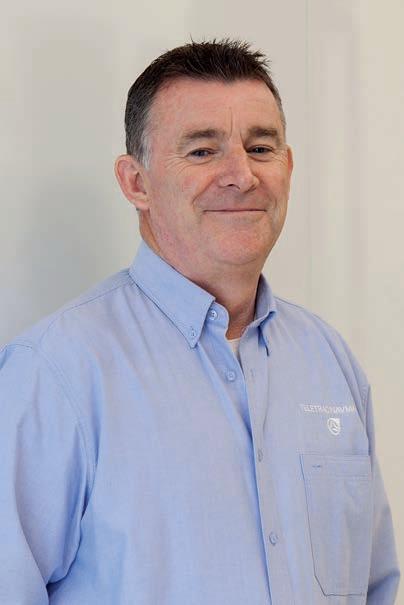
“Having a single entity means the users don’t need to use different software packages. It’s a complete solution.”
Teletrac Navman is looking to make further enhancements to the Smart Dashcam model to advance its capabilities as a predictive analysis tool, through improvements to its AI engine, as well as the range of in-built alert metrics.
roadsonline.com.au 25 SAFETY
“THIS PUSH TOWARDS AI-ENABLED CAMERAS IS TO SEE WHAT THE DRIVER IS DOING, TO GIVE YOU A GREATER INDICATION OF THE DRIVER’S PERFORMANCE.”
Teletrac Navman’s AI camera technology can detect and alert when road incidents and accidents occur.
James French, Construction Solution Specialist at Teletrac Navman.
LEVEL UP

NEVER IDLE

In this game, there’s no substitute for experience. But finding expert Motor Grader operators can be tougher than the terrain they’ll be tackling. That’s why John Deere is the only player in Australia to be offering Motor Grader automation upgrades to all machines from 2019 onwards. Spec’d out with the latest tech including Machine-Damage Avoidance, Auto-Articulation, Auto-Pass, Auto-Shift Plus, and Blade Stow, less experienced operators can get to grips with the machine double quick, and takes the pressure off your more experienced hands. Take your operation to a whole new level. Check your serial number with your local dealer, today.
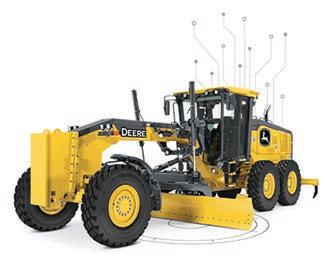

DEERE.COM.AU/SMARTGRADEMOTORGRADERS SCAN TO LEARN MORE
MOTOR GRADER JOB SITE AUTOMATION
EXCELLENCE THE MEDIAN OF
Chave long been a preferred tool in increasing the safety and reducing the likelihood of road trauma on Australian roads.
As stated in VicRoads’ 2018 Road Design Note, central barriers are “presently one of the most effective treatments for reducing the likelihood and severity of head-on crashes and align towards providing safe systems for road users”.
A study into the barriers has revealed that they can provide an 87 per cent reduction in fatal median related incidents, including head on crashes, over a six-year data collection period before and after installation (‘Digesting the safety effectiveness of cable barrier systems by numbers’ – D. Chimba, E. Ruhazwe, S. Allen, J. Waters).
Ingal Civil is a pioneer in the manufacture and distribution of highway safety barrier systems, making meaningful impacts on
roads nationwide.
This also includes investment into the development and research of new products which aim to increase the safety of road connections for motorists.
The Austroads Safety Barrier Assessment Panel has recently recommended for acceptance the TREND Median terminal, a new and improved addition to Ingal Civil’s central barrier product line-up.
According to Ingal Civil Product Manager Luke Gallagher, the TREND Median guardrail terminal is helping to modernise the catalogue of available road safety systems on the market.
“Wire Rope Safety Barriers have long been a preferred barrier type in medians, due to their costs and installation time,” he says.
“They’re great for expressways or roads that have long runs and plenty of room for


focus is moving to barriers closer to urban and built-up areas, where speeds are reduced and the horizontal curvature is reduced.”
As a result, manufacturers have had to make adjustments to increase the adaptability and flexibility of road safety barriers for varying installation environments.
The TREND Median guardrail terminal is a double sided, gating re-directive and impact absorbing end terminal. This terminal is used with longitudinal road safety barriers and can be applied to a number of applications, such as roadside shoulders, as well as unidirectional and bidirectional traffic.
Trialled and tested according to Test Level three of the MASH (Manual for Assessing Safety Hardware) testing regulations, the TREND Median guardrail terminal can absorb the kinetic energy of a vehicle, bringing it to a controlled stop from 100km/h.
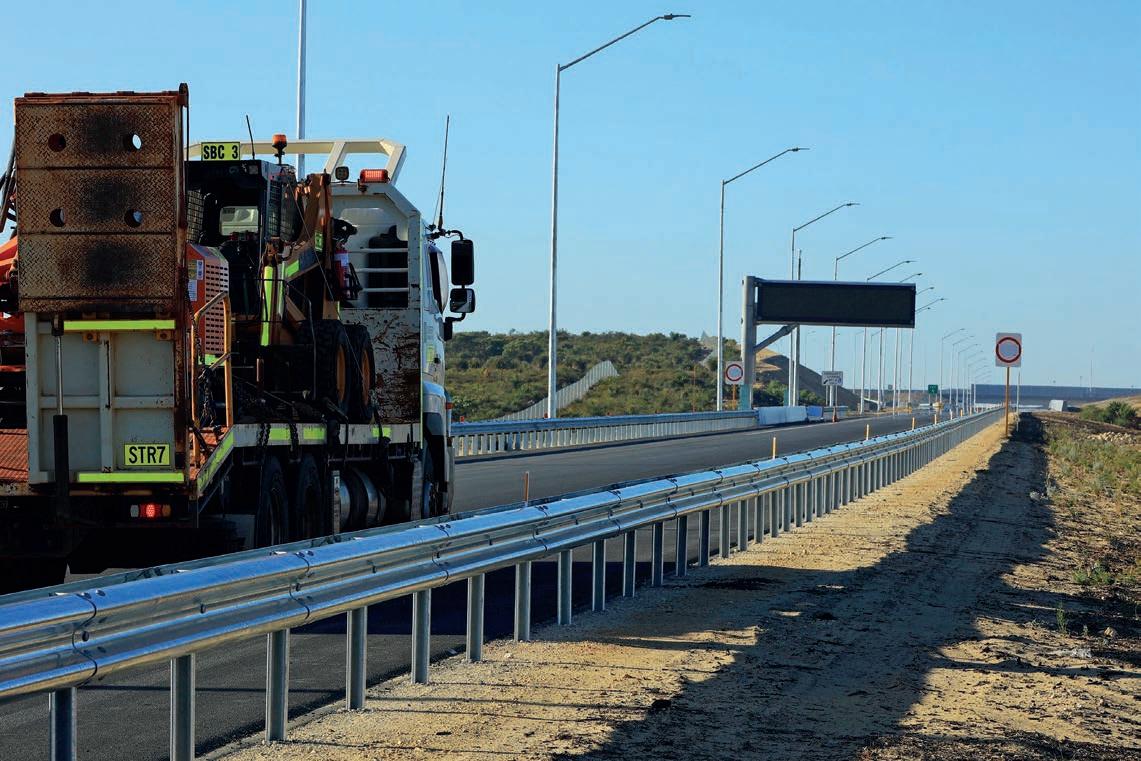
roadsonline.com.au 27 SAFETY
INGAL CIVIL HAS ALWAYS BEEN A KEEN SUPPORTER OF HIGHWAY SAFETY BARRIER
The TREND Median guardrail terminal installed on a local road in Western Australia.
This is thanks to the barrier’s unique slotted rail and shaper-fin design. This concept allows a cutter-bolt to sheer through the barrier slots, with the shaper-fin deforming the rail upon impact.
BENEFITS OVER OTHER BARRIERS
The TREND Median terminal offers a variety of benefits over other road safety barrier options currently available in the market, as Gallagher explains.
“Concrete barriers can be five or six times more expensive than a median guardrail barrier,” he says. “So they’re cost prohibitive most of the time.”
When compared to conventional wire rope safety barriers, the TREND Median terminal can hold its own.
“With wire rope, a single impact can cause a lot of damage to the barrier. With a back-toback guardrail, even if you clip or scratch the barrier with your car, it typically doesn’t need immediate maintenance to repair its integrity,” Gallagher says.
“Most wire rope barriers can also require concrete footings and anchor blocks as part of the installation. The TREND Median terminal can be fully commissioned and installed in just one day, with the installer driving the posts into the ground, instead of waiting for concrete to set.”
The VicRoads’ 2018 Road Design Note also states that back-to-back road barriers can sustain secondary hits, whereas wire road barriers can be disabled after a significant incident. An important consideration for regional roads, where the response time for maintenance may be delayed.
“Having space for deflection as well as a lower life cycle cost are big differentiators,” Gallagher says. “Some wire rope barriers might be cheaper to install, but more expensive to maintain in the long run.”
Back to back guardrail systems also provide significant drainage when compared to other road safety systems, such as concrete barriers which can have an effect on the surface flow of metropolitan and regional roads.
INSIDE THE INSTALLATION
Safety Barriers WA is one company who has already installed the Median Ezy-Guard barrier as part of it services.
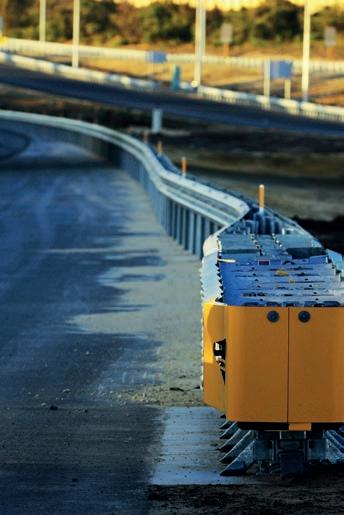


Glackin has received additional positive feedback from other installers, who say the process helps to save both time and money.
“Our installers commented on the ease of which they can layout materials in preparation for installation. They noted a significant weight difference in the post and slider assemblies and how much more materials they could carry from the laydown area to the worksite,” Glackin says.
Etienne Fourie, Senior Associate at BG&E says the TREND Median guardrail terminal’s simplicity for installation, as well as the support of Ingal Civil were major benefits.
“We selected the ezy-guard median barrier




Patrick Glackin, Project Manager, says the installation of the median guardrail is comparably easier than other systems on the market.
“The installation process for MASH systems such as Ezy-Guard is in general is much more efficient than standard conventional systems. Due to the reduced length and smaller footprint, the posts seem to penetrate through the ground much faster than their conventional counterparts,” Glackin says.
“The slider block system used in Ezy-Guard is also much faster to attach to the post and secure the rail than that of the old plastic block method, especially when the task is doubled on median systems.
based on its ease of construction and a suitable barrier within a median based on location, available verge width and space for deflection. We also selected it because we were able to install the barrier only on one carriageway saving installation time and material,” Fourie says.
“I personally liked the simplicity of the system and installation seemed fairly easy and quick. I also appreciated the support we received form James and the team.”
The Ezy-Guard 4 Median system, which is available now, has already been deployed at sites in Western Australia, with expectations that the product will have a wider rollout across Australia.

28 ROADS MAY 2023 SAFETY
“WITH WIRE ROPE IN NARROW MEDIANS, NUISANCE IMPACTS CAN BE A BIG PROBLEM FOR ASSET OWNERS. BACK-TO-BACK GUARDRAIL IS MUCH MORE TOLERABLE OF THESE IMPACTS AS THE POSTS ARE MORE ROBUST, MEANING LESS MAINTENANCE AND LOWER LIFE CYCLE COST.”
The TREND Median guardrail terminal has
a comparatively easier installing process when compared to other road safety barriers in the market.
A back-to-back guardrail is designed to protect motorists from lane departures across the median into oncoming traffic.


































TO IMPROVEMENT COMMITTED
COFFEY TESTING IS CONTINUALLY IMPROVING ITS RADIATION MANAGEMENT PROCESSES AND TRAINING TO ENSURE THE SAFETY AND WELLBEING OF ITS STAFF.
For more than 60 years, Coffey Testing has become synonymous with geotechnical testing for infrastructure projects of all sizes.
Providing testing for aggregates, soft soils, rock, grout and concrete, the company has provided geotechnical services as part of the development of some of Australia’s largest road projects, such as M1 Pacific Highway project, as well as the Bruce Highway Upgrade.


As part of its materials testing services, Coffey Testing utilises equipment that contains a radioactive source to determine the insitu density of soil.
Brooke Scott, Coffey Testing Safety and Wellbeing Manager, says the company, which is considered one of the largest providers of material testing, has robust procedures and training programs in place to ensure the health and safety of its staff and compliance to regulatory requirements.
“It’s important to make sure that the appropriate controls are in place when our staff are using, storing, and transporting soil moisture density
gauges, therefore we’ve got the systems, processes and training in place meet each of these requirements,” Scott says.
Coffey Testing can utilise its ISO/ IEC 17025 NATA accredited testing laboratories in multiple sites across Australia, reducing the call out time and increasing the accuracy of timely results.
Some of Coffey Testing’s staff of 200 technicians nationwide are also local to their respective regions, providing more knowledge around ground conditions unique to each area. The company’s local capabilities are also backed by international best practice when it comes to both equipment and conformance standards.
LEADING THE WAY
In order to operate and transport soil moisture density gauges, individuals must be a licensed operator with the relevant regulatory body, such as the Department of Health Victoria or New South Wales Environment Protection Authority.
As part of Coffey Testing’s
commitment to the safety of its people, the company is aiming to go above and beyond just an accreditation. This has led to the development of in-house and external training services.
Coffey Testing is currently certified to deliver an accredited Radiation
Coffey Testing offers its Radiation Safety Training Course across New South Wales, the Northern Territory and Western Australia.
Safety Training Course across New South Wales, Northern Territory and Western Australia. Not only for its own staff across the company’s 25 locations nationwide, but also for external participants, with an aim to expand into other states in the near future.

“As one of only a few companies to have an accredited Radiation Safety Training Course, it allows us to train our own people to enable them to gain the appropriate skills and knowledge to obtain their radiation licence, plus also deliver the training externally to anybody in the industry in NSW, NT and WA,” Scott says.
Out of the total number of the Radiation Safety Training Course participants in 2022, 22 per cent were external to Coffey Testing.
Scott says Coffey Testing is always looking to support the industries it serves. Whether it be through the training programs, or utilising the company’s five decades worth of experience in materials testing.
“Prior to starting a project, we always consult with the client to conduct risk assessments and ensure appropriate controls relevant to the environment in which we are working are put in place,” Scott says.
“It’s an interactive process too. It’s important to work together with the client to ensure their requirements are met and all the appropriate controls are implemented.”
Coffey Testing will be conducting further updates to its radiation management plans for each state and territory, while also adopting new equipment and technologies.
“We’ve implemented GPS tracking devices on all of our soil moisture density gauges, to better track and secure radioactive sources,” Scott says.
More employees will also have a chance to undertake the radiation refresher course over the coming months, further cementing Coffey Testing’s geotechnical expertise in radiation.

roadsonline.com.au 31 SAFETY
“WE’VE IMPLEMENTED GPS TRACKING DEVICES ON ALL OF OUR SOIL MOISTURE DENSITY GAUGES, TO BETTER TRACK AND SECURE RADIOACTIVE SOURCES.”
Coffey Testing uses established programs and equipment.
YOUR TOTAL SOLUTION FOR ASPHALT AND CONCRETE


Lintec & Linnhoff is a global manufacturer and distributor of leading-edge solutions for the asphalt and concrete industries. Under the Lintec, Linnhoff and Eurotec brands, our products include asphalt mixing plants, concrete batching plants, pavement related technologies and specialist concrete cooling solutions. The Lintec containerised asphalt and concrete batching plant series, built in 100% certified ISO sea containers is one of our key technologies.
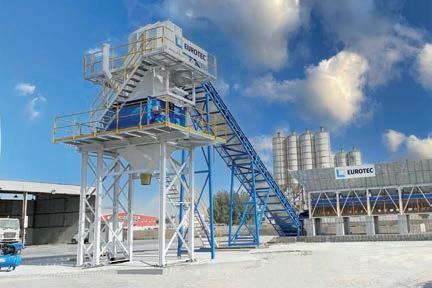
www.lintec-linnhoff.com • info@lintec-linnhoff.ccom

 Lintec CDP mobile continuous asphalt mixing plant
Linnhoff TSD MobileMix asphalt mixing plant Lintec CSM containerised asphalt mixing plant Eurotec Eco concrete batching plant
Lintec CDP mobile continuous asphalt mixing plant
Linnhoff TSD MobileMix asphalt mixing plant Lintec CSM containerised asphalt mixing plant Eurotec Eco concrete batching plant
IMPROVEMENT THE ROAD TO
MAJOR CONSTRUCTION IS UNDERWAY ON THE EPPING ROAD UPGRADE IN MELBOURNE’S NORTH-EAST. MRPV PROGRAM DIRECTOR, ADRIAN FURNER, EXPLAINS THE STAGES OF DEVELOPMENT, PROGRESS, AND GOALS POST-UPGRADE.

Since the early stages of development in 2018, works on the Epping Road upgrade have had a strong focus on safety for commuters in and around the community, as well as increasing liveability and commercial development opportunities for the Wollert area.
Major Road Projects Victoria is delivering the project as part of the $3 billion Suburban Roads Upgrade package for improvements across suburban Melbourne.
Program Director Adrian Furner says the ongoing works involve a suite of up to 21 priority roads in the north, southeast and western outer suburbs.
“The Epping region is considered a fastgrowing suburb in Melbourne, so demand was growing to increase the area’s road capacity,” he says.
“This meant the Department of Transport and Planning, who are responsible for identifying these roads, decided Epping Road would be its next priority.”
As part of the Epping Road upgrade, extra lanes will be added between Craigieburn Road East and Memorial Avenue, and six key intersections will be improved.
Furner says safety was a big focus due to the increasing population.
“With more people and local schools in the vicinity, one of the main features of this project is how it will improve safety for all road users travelling through the area,” he says.
“The major priorities focus on right turn intersections being made safe, barriers to protect shared walking and cycling paths and making routes more efficient.”
Furner explains that benefits for traffic will come as the project continues.
“The intersection of Park Street and Epping Road will be signalised to increase the safety for motorists and pedestrians on Epping Road. The project hopes to improve traffic reliability - and safety - and get people where they need to be sooner.”
The upgrades include extra lanes in each direction between Craigieburn Road East and Memorial Avenue, new traffic lights at Park Street, the improvement of existing intersections at Craigieburn Road East, De Rossi Boulevard, Baltrum Drive, Harvest Home Road and Lyndarum Drive and the upgrade of the pedestrian traffic lights at Taggerty Grove.
The area is also expected to receive a new shared walking and cycling path from Lyndarum Drive to Craigieburn Road East, on-road bicycle lanes from Memorial Avenue to Lyndarum Drive and the installation of road safety barriers along Epping Road.
With early works underway since mid-2022 and major construction now beginning, Furner says he is proud of the major milestones hit so far.
“We’ve established our main construction site for the site compound and offices to build the road on the Craigieburn Road

East section. We’ve also installed safety barriers along Epping Road to allow access for works associated with service and utility relocations, including power, gas, water, and telecommunications that need to be protected,” he says.
“We are also working on temporary pavement along High Street so we can build the new southbound lanes in that area. Later this year, we’ll be looking forward to the beginning of the key intersections around Memorial Avenue and Craigieburn Road.”
Furner hopes travel benefits for the community will continue to be prioritised.

“Travel times and improved connectivity are key priorities for everyone, even those extending past your typical road user,” he says.
“We hope the project continues to provide easier access to jobs and services and allows easier travel for people navigating from the local residential community to their activity centres, schools, and
roadsonline.com.au 33 PROJECT REPORT
Preparing to build the new southbound lanes on Epping Road.
commercial businesses in the area.
“We also want to make it easy for people to walk and cycle safely around their local community and lower the risk and severity of any crashes that may occur along the alignment.”
With these milestones comes challenges, but Furner says these challenges are being looked at as opportunities rather than roadblocks. He says one example of this was the Wollert Church relocation.
The Methodist Church served as a place of worship for over 120 years and holds both historic and social value in the community.
In May 2022, the church was relocated to Carome Homestead in Mernda to make room for the upgraded intersection at Lehmanns and Epping roads.


Furner says this relocation represented a
MRPV and the community.
“The relocation was adopted by the project team, in consultation with community representatives and Working Heritage, to identify and relocate the historic building to a location nearby,” he says.
“It has now been reconstructed and commissioned so that the community can continue to benefit from this structure for many years to come.”
UNDER THE PDA
The upgrade is being delivered under MRPV’s Program Delivery Approach (PDA), which awards road upgrades to contractors based on capability, capacity, past performance, and ability to deliver value-for-money solutions to the industry.
The construction and upgrades underway on the Epping Road project have been operating under the PDA since the contract was awarded in 2022.
The approach helps with an increasing demand for large road projects and, according to Furner, brings a greater volume of work to market quicker.

“The PDA is intended to provide greater value for money and transparency for Victorian taxpayers.” Furner says.
“We’re now able to stage our projects
all tiers of the market, whilst also working collaboratively with our contractors.
“This means better outcomes and greater efficiency is achieved over time.”
Furner says contractors have been able to break through barriers to entry for growth in the market, something he is excited to see.
“Smaller contractors continue to have a great sustainable workload to provide continuity for their growing teams. They can now grow into greater roles as the project is delivered and benefit from social procurement initiatives, skills and guarantees,” he says.
“After working with multiple forms of contractual models, the PDA stands out in achieving a collaborative, positive working environment while recognising that value is far greater than the dollars we spend.”
Furner says his goal with the completion of the project is to continue seeing the upgrade of roads in outer suburban areas as a critical priority.
“We want to thank the whole community as guests of their neighbourhood while we are under construction. In continuing to work with us, we will get people where they need to be safer and quicker as a result.”
The upgrade is expected to be complete in 2025.
34 ROADS MAY 2023 PROJECT REPORT
Crews get ready for construction to begin on Epping Road.
The Wollert Methodist Church’s new home at Carome Homestead in Mernda.
A new approach to understanding sustainability across your fleet

Understanding the term sustainability and safety is the first step toward having a measurable impact. Where artificial intelligence turns data into insight, it empowers meaningful insights into sustainable practices.
Health & Safety
Analtyics to curb poor behaviour and improve on safety through coaching.
Sites of cultural significance

Tech to protect & promote sustainabile innovative projects.
Preserve natural ecosystems
Ensure the protection of the environment for the future generations.
NetZero
Data to reduce carbon emissions to contribute toward Net Zero.
1300 111 477 TeletracNavman.com.au TN360
KEEPING IT MOBILE
TOPCOAT ASPHALT CONTRACTORS’ MOBILE ASPHALT PRODUCTION PLANT IS PROVIDING FLEXIBILITY TO THE COMPANY’S EXPANDING NATIONAL SERVICE OFFERINGS. DANIEL RENSBURG-PHILLIPS, BUSINESS DEVELOPMENT MANAGER SHEDS LIGHT ON THE SYSTEMS CAPABILITIES.

Topcoat Asphalt is one of the fastest growing asphalt manufacturers in South Australia. Essential to the company’s growth was the quality and quantity of asphalt produced from its fixed asphalt plants.
Daniel Rensburg-Phillips, Business Development Manager says that Topcoat identified an opportunity to expand its operations by embracing mobile asphalt production methods and procured its mobile asphalt plant.
Differentiating itself from the competition, Topcoat’s mobile asphalt plant can be established quickly and cost effectively for both large- and smallscale projects.
“In 2019 we underwent a large refurbishment [of the mobile asphalt plant]. At the time we already had two fixed asphalt production facilities,” Rensburg-Phillips says.
“We started to see more opportunities in regional South Australia, as well as places such as Alice Springs. With
our fixed facilities, we were limited somewhat by the travelling capacity, time frames and workability of asphalt for longer distances.”
Since its refurbishment, Topcoat’s mobile asphalt plant has been mobilised as far as Alice Springs for only 900 tonnes, and as close as the SA Riverland for more than 25,000 tonnes.

A quick and cost-effective establishment brings Topcoat’s customers value by mitigating the time lag between asphalt production and placement, reducing haulage trucks on the road and increasing serviceability of regions once “too small” for “traditional” mobile plant offerings.
It also helps to reduce quality issues
36 ROADS MAY 2023
Topcoat Asphalt’s mobile asphalt production plant on site.
Topcoat Asphalt has deployed its mobile asphalt plant for works in Alice Springs, as well as rural South Australia.
through placing temperatures and close to real time NATA production reporting, and minimises construction waste, preserving valuable natural resource.
The benefits of the mobile asphalt plant mean Topcoat Asphalt is now completing jobs in Alice Springs, as well as the Riverland and South-East regions of South Australia.
BENEFITS FOR BUSINESS
The benefits of the mobile asphalt plant were highlighted during major works as an asphalt supplier for BMD Constructions. The project featured the construction of two new roundabouts, approximately 15 kilometres apart.
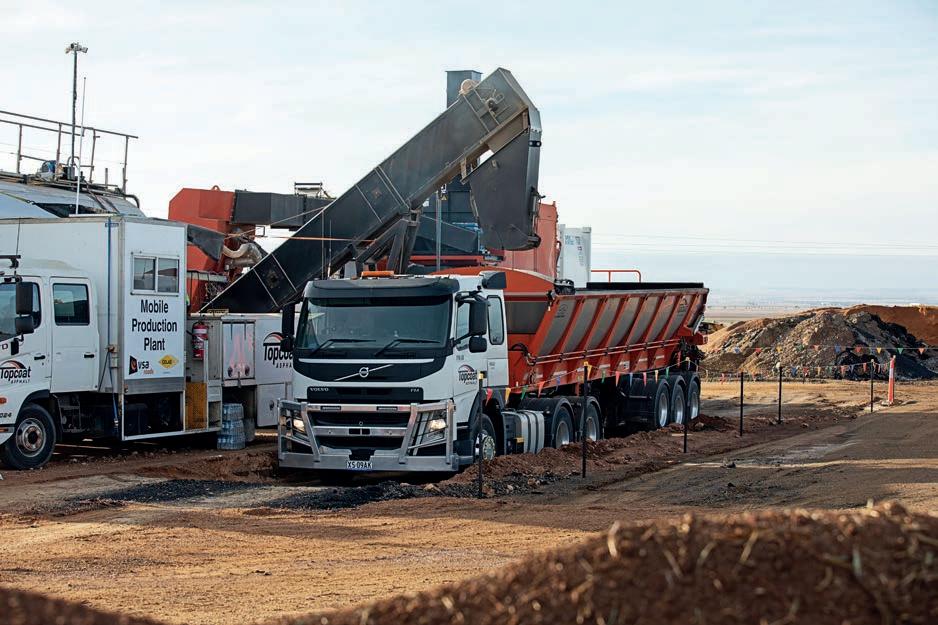
Rensburg-Phillips says the mobile production capability of Topcoat Asphalt was a major factor in the company being selected for the project.
“We located site between the two roundabouts where we set up our mobile asphalt plant and NATA accredited laboratory,” he says.
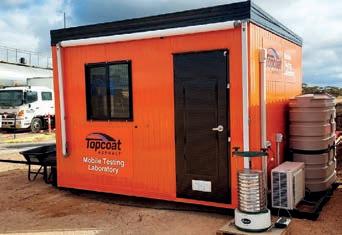
“We supplied asphalt direct to the project, replacing the 15 trucks it would’ve taken to deliver the asphalt from a fixed plant in Adelaide. Establishing our NATA accredited mobile laboratory adjacent to our mobile asphalt plant removed the need to transport production samples three hours back to our NATA accredited Wingfield laboratory. We were able to test on-site close to real-time as the project progressed.”
The mobile asphalt plant was quick, nimble and cost effective to establish, reduced the number of trucks on local roads, mitigated quality issues due to proximity to the project, and saved overall costs for BMD Constructions and project owner, the SA Department for Infrastructure and Transport.
Rensburg-Phillips adds that flexibility is another major bonus for mobile asphalt plant set-ups.
“It helps to ‘de-risk’ the project and allows for program flexibility from the client’s side,” he says.
STEADY SUPPORT
Topcoat’s mobile asphalt plant, and the company in its entirety, are backed by the support of parent entity VSA Roads and VSA’s major shareholder Colas Australia Group (CAG).


Rensburg-Phillips says SAMI Bitumen
Technologies (CAG’s bitumen business) have been a supporter of Topcoat’s mobile asphalt plant, and have complemented Topcoat’s focus on retaining quality through mobility.
“SAMI has recently established supply of containerised bitumen, so they’re able to support us by cost effectively facilitating base and polymer modified bitumen delivery to just about anywhere in Australia,” he says.
NEW OPPORTUNITIES
Rensburg-Phillips says the mobile asphalt plant has helped to open new doors for Topcoat, and is supporting
the company’s expansion into the national marketplace.
“It’s allowed us to compete for projects that were previously unattainable due to our fixed plant position,” he says.
“We’re successfully supporting our increasing customer network by deploying our mobile asphalt plant, and becoming a specialist delivery partner rather than a downstream contractor.”
Working closely with regional material suppliers, Topcoat seeks to incorporate a larger suite of raw material constituents into its mobile asphalt plant mixes production that conform to regional specifications and standards.
roadsonline.com.au 37 MACHINERY & EQUIPMENT
“WE’RE SUCCESSFULLY SUPPORTING OUR INCREASING CUSTOMER NETWORK BY DEPLOYING OUR MOBILE ASPHALT PLANT AND BECOMING A SPECIALIST DELIVERY PARTNER RATHER THAN A DOWNSTREAM CONTRACTOR.”
The mobile asphalt plant helps to reduce costs for transport and production.
Topcoat Asphalt can now greater service projects in rural and regional areas.
Topcoat Asphalt’s on-site mobile laboratory.


Connecting talent with industry. powered by careerone hiring.roadsonline.com.au ADVERTISE JOBS TODAY & INFRASTRUCTURE
ROLLING OUT THE UPGRADES
THE CB2.7 GC IS ONE OF CATERPILLAR’S MOST FAVOURED PAVING MACHINES NATIONALLY, WITH POPULARITY ONLY EXPECTED TO GROW. CHRIS HARKNESS AND DEAN ALLEY FROM CATERPILLAR GIVE INSIGHT INTO THE VERSATILE ROLLER AND THE FEATURES THAT SET THIS MACHINE APART.


specifics including a range of updates to improve operator experience.

“It’s important to be able to see the outside of the drums when in operation. We have tapered this so operators have a clear line of site when working,”

“This improves efficiency greatly. You don’t have to lean too far or even leave the machine to see where the drum aligns. The narrow drum means a clear line of sight directly from where you’re sitting.”
Efficiency also comes from the new compaction measurement value (CMV) displayed to the operator for improved compaction performance and consistency.
Territory Manager Dean Alley says features like this allows operators with a range of skill levels to use the roller
asphalt compaction,” he says.
“It is designed to let the operator know when the machine has reached the desired compaction level – and it does this job extremely well.”
Development of the CB2.7 GC also considered safety a high priority.
Some of the key safety specifics include a new 76 millimetre high-visibility orange seatbelt, optional LED lighting for night works and a seat with an operator presense sensor to prevent unintended operation while out of the machine.
SIMPLER TO OPERATE
Another key aspect of the CB2.7 GC is the updated water spray system.
Alley says the updated system is an essential part of the machine, made to be noticeable and easily accessible.
“We’ve worked hard to optimise the whole water spray bar system,” he says.
“The gauge is in a place where you can easily understand water levels, an aspect that was essential through the development stage. We also made sure to keep Cat’s triple filtration system so the water remains clear of any possible debris, making it easy for operators to see.”
The water spray system also comes with an optional test mode, another key feature acknowledging safety as a priority. Harkness says that, especially with asphalt compacting, being able to test where the water is spraying is critical.
“The CB2.7 GC spray test mode means you don’t need to leave the machine idling and creating noise to test the water spray,” he says.
roadsonline.com.au 39
The CB2.7 GC is suitable for any level of skill.
The Cat CB2.7 GC roller is a small machine with big capabilities.
“You can simply turn a dial located on the machine to switch to test mode, get out of the roller and check that the nozzles are spraying correctly and that there are no blockages in the way to optimise coverage.”
Harkness says Caterpillar wanted to ensure this system worked well for operators, knowing the importance of water.

“In the business of asphalt, if you run out of water, you might as well run out of fuel. If water runs out, the system will begin picking up asphalt and causing damage to the machine. The test-mode is designed to avoid these risks,” he says.
“Having a water level gauge just a quick glance away is designed to assist in quick and efficient monitoring – perfect for this easy-to-use machine.”
The development and upgrades of the new CB2.7 GC originated from one simple thing, operator feedback. Harkness says that feedback from the very people the machines are designed for, is the reason why each iteration of the roller keeps getting better.
“Operator feedback is very important
in the development of any machine Caterpillar provides,” he says
“People using the equipment were reporting that there wasn’t enough coverage, so we made sure to add an extra nozzle for water spray and an internal application across the drum.”
Other productivity specifics of the CB2.7 GC include new 14 millimetre thick drum shells for longer durability and two vibe frequencies for simple and versatile operation.
ENSURED PEACE OF MIND
Upgrading the CB2.7 to the CB2.7 GC also meant the upgrade of the engine.
Alley says the C1.7T engine with 18.4 kilowatts is Tier 4 ready.
“The new compactor line-up features an electronic technician (ET) that is built into the C1.7T engine with diagnostic software which enables quicker access to diagnostics,” he says.
“Through ET, you have the ability to capture critical information around the operating data as well as track the machine’s location.
Mobile Asphalt Plant
Topcoat Asphalt has the ability to deploy our mobile plant to suit any project, at any location within Australia.
WHY USE THE TOPCOAT ASPHALT MOBILE PLANT?
• Can be established quickly and proficiently in remote locations
• On-site material and asphalt testing ensures quality and efficiency

• Available for short and long term project needs
• Flexibility to configure to suit the project and the location

• EPA Licenced, subject to site specific notifications.

“It gives you a sense of safety and reassurance for your equipment; very useful in case of stolen or missing property.”
According to Caterpillar, the updated engine also has a 55-litre fuel tank for longer run times and comes with an auto idle shutdown feature for fuel economy.
QUALITY AND RELIABILITY
Harkness says Cat dealers’ after market offers is what really sets them apart.
“The CB2.7 GC roller is Cat’s biggest selling roller, but despite the flexibility, easeof-use and efficiency, our after-market offers, and extended warranties offered by our network of dealers is what makes us unique,” he says.
Alley continues the emphasis on Caterpillar’s service.
“We always jump at the opportunity to offer aftermarket service to our customers through our dealers,” he says.
“This all plays a huge part in what Cat is about.”
The updated CB2.7 GC roller is now available in the Australian market.
MACHINERY & EQUIPMENT topcoat.com.au
TOPCOAT ASPHALT 50 – 54 Millers Road, Wingfield, SA 5013 T: (08) 8347 2030 E: info@topcoat.com.au PAR TNER S topcoat.com .a u
EMPOWERING TEAMS ON THE GO
REVIZTO HAS ANNOUNCED THE LAUNCH OF ITS FULLY FUNCTIONAL PHONE APP, DESIGNED SPECIFICALLY FOR THE ARCHITECTURE, ENGINEERING, CONSTRUCTION AND OPERATION/OWNERS INDUSTRY.

Revizto’s new app empowers users to access, manage, and collaborate on construction and infrastructure projects effortlessly, right from the palm of their hands.
With the app, users can access all of their project data, including sheets and 3D models, and track issues from their phones.
This will enable them to review and collaborate on project information from anywhere, at any time, without being tied to a desktop computer. The app’s intuitive interface and user-friendly features make it easy for anyone to use it, on the go and on construction sites.
Arman Gukasyan, Founder and CEO of Revizto, says the app provides flexibility. “We recognize the vital role of mobility
Users can also enable broader usage among teams and stakeholders, helping to bridge the gap between different disciplines and foster a more collaborative and productive working environment.
Customers can take the project with them and work from any location, whether they’re online or offline. With no boundaries to collaboration, users can maintain productivity and seamless teamwork.
The app is also included with any Revizto license. Meaning users who are already Revizto users can download it today.
Jason Howden, Principal – Digital Innovation Leader, Warren and Mahoney is one of many customers who have already used the platform.
Split 2D/3D
Object properties
and accessibility in today’s dynamic industry. With the new app launch, we are excited to empower Revizto users to access, explore, and collaborate on projects anytime, anywhere. We are confident that this ground-breaking app will redefine the way AECO professionals work and collaborate around the world,” Gukasyan says.
A key benefit of the new app for users is providing project management on the go. Users can effortlessly manage projects from the office to the field, with full access to all design and construction data, including 3D models, drawings, point clouds, and more.
Users can also benefit from real-time collaboration by facilitating seamless communication between teams with swift issue tracking, ensuring everyone stays informed and aligned throughout the entire project lifecycle.
“Revizto’s phone app puts the construction site in your pocket, making BIM accessible to everyone in the supply chain, from the CEO to the plumber. With a complete re-engineering, Revizto has realized a BIM vision and dream, bringing it to life now, not in the next 5-10 years,” he says.
Shaun Carollo, VDC Manager, Hoar Construction says that he was able to benefit from the app’s interface, despite only having limited experience with it.
“I used the app for five minutes and definitely left thinking it would lead to more adoption in the field by our internal project teams as well as the subcontractors. Being able to fly the model with how light/easy it was, while going through issues in both 2D and 3D will definitely help,” Carollo says.
The app is available now for iOS and Android phones.
Appearance templates Stamps
Joystick navigation
Orbit view
3D ruler
Issue tracker
2D ruler
Sheet overlay
Section cut Levels
Point clouds
roadsonline.com.au 41 MACHINERY & EQUIPMENT
“REVIZTO’S PHONE APP PUTS THE CONSTRUCTION SITE IN YOUR POCKET, MAKING BIM ACCESSIBLE TO EVERYONE IN THE SUPPLY CHAIN, FROM THE CEO TO THE PLUMBER.”
The app allows users to take the project with them and work from any location.
SUPPLYING BATTERY POWER TO A VARIETY OF INDUSTRIAL
APPLICATIONS
TOSHIBA INTERNATIONAL CORPORATION’S SCiB RECHARGEABLE BATTERY HAS BEEN DESIGNED TO CATER FOR A VARIETY OF APPLICATIONS, WHERE RAPID HIGHPOWER CHARGING AND DISCHARGING, WIDE TEMPERATURE RANGE OF OPERATION, LONG PRODUCT LIFE AND ESPECIALLY WHERE HIGH DEGREE OF SAFETY ARE PRIME REQUIREMENTS.

Meaningful strides have been made in the electrification of the infrastructure sector. The development of new technologies, such as a wider rollout of electric vehicle charging stations, is helping to accelerate change while promoting lowering of the sector’s carbon footprint.
Whilst the adoption and development of adequate infrastructure to support the shift away from traditional energy sources has taken time, the electrification of assets is now becoming within industry’s reach.
The adoption of Toshiba International Corporation’s SCiB rechargeable Battery to power a variety of mechanised industry applications contributes significantly towards the long-term goal of meeting net zero emission targets.
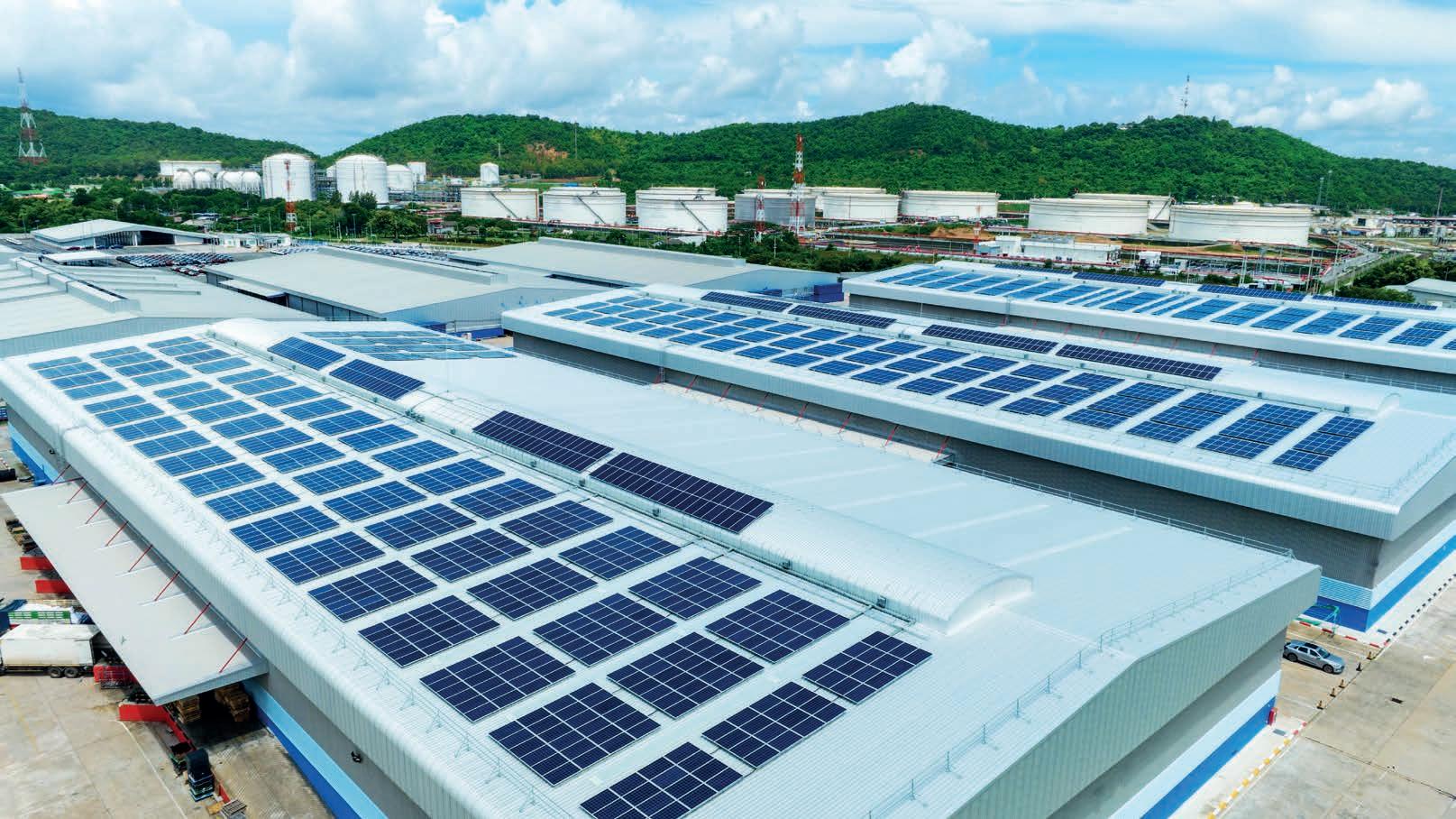
The application of SCiB Batteries in electric vehicles for example provides for a much less complex design, a lower cost of maintenance and lower operating costs whilst at the same
time delivering a sustained long-term return on investment, including the provision of financial, environmental and efficiency improvements.
This not only applies to vehicles but for associated equipment and related infrastructure facilities.
Years of research and development has provided Toshiba with extensive experience in manufacturing batteries.
A unique feature of the SCiB Battery is that Lithium Titanate Oxide (LTO) is used for the anode construction in place of traditional Lithium-Ion, resulting in a high product longevity well in excess of the capability of conventional Batteries.
With almost zero maintenance required, these Batteries provide a set-and-forget solution—delivering a saving in time, money, and effort.
SIGNIFICANT BATTERY BENEFITS
The SCiB Battery delivers a minimum 20,000 cycles lifespan, which can equate
42 ROADS MAY 2023
The SCiB can be charged to 80 per cent capacity in just six minutes.
to many years of operation before needing replacement.
The battery can also be charged to 80 per cent capacity in just six minutes, making it well-suited for frequent use.
The rapid charging capability makes the SCiB Battery ideal for e-cars in everyday use. Their compact size and high energy capacity means fewer batteries are needed on board, delivering more passenger space and reduced costs for larger applications, such as e-buses and e-trucks where stored regenerated energy is used which enables longer distances to be achieved.
The Battery has also proven to be effective in hybrid electric vehicles, cranes, electric buses, electric ships, trains, electric trucks and applications where energy storage is paramount.
The large rooftop surface of vehicles such as buses and trains enables solar panels to be mounted to generate additional electricity for auxiliaries, which is stored within the Batteries.

The SCiB Battery is built using a unique manufacturing method that reduces the risk of fire or explosion when the product is exposed to external pressures. The SCiB has also been designed to withstand
temperatures as high as 45°C and as low as -30°C.
The modules themselves include an integrated Cell Management Unit that handles balancing and temperature monitoring on individual cells.
It is due to these features that the SCiB has also become a popular choice especially for the mining sector, in particular with underground vehicles where large energy capacity and low risk of fire factors are paramount.
IN SAFE HANDS
Toshiba International Corporation understands the potential of this technology, as well as how important optimising the technology can be for achieving sustainable outcomes.
As such, the Company is proud to provide services in both training and installation, to help take the guess work
out of realising savings in adopting an SCiB battery system.
Toshiba International Corporation’s Engineers work closely with their clients to build custom solutions based on individual business requirements, which is an added value in assisting clients to design a cost effective and optimal system solution using SCiB products.
From system management perspective, Toshiba’s own Battery Management Unit looks after all the housekeeping for the Battery string combinations.
All that is required is to simply connect to a customer’s control system via Ethernet or CAN communication.
By contacting Toshiba International Corporation’s SCiB rechargeable Battery Engineering team, customers can gain a better understanding of why the battery is well suited to the infrastructure sector and applications.
roadsonline.com.au 43 MACHINERY & EQUIPMENT
“THE BATTERY HAS ALSO PROVEN TO BE EFFECTIVE IN HYBRID ELECTRIC VEHICLES, CRANES, ELECTRIC BUSES, ELECTRIC SHIPS, TRAINS, ELECTRIC TRUCKS AND APPLICATIONS WHERE ENERGY STORAGE IS PARAMOUNT.”
The SCiB can withstand temperatures as high as 45°C and as low as -30°C.
Donald Cant Watts Corke is one of Australia’s leading providers of independent end-to-end project services

Providing a wide range of end-to-end project services for over 50 years, we have proven our expertise and reliability in helping ensure the successful delivery of infrastructure projects throughout Australia. Through a holistic approach, we provide you valuable advice and assurance with our quantity surveying, project management, advisory, and engineering services, tailored to ensure your project reaches its full potential.
Our in-depth understanding of the infrastructure sector enables us to develop the right solutions that address the complex needs of your project. We are committed to delivering outstanding results for Australia's future.
Learn more at dcwc.com.au

Delivering integrated solutions ADELAIDE BRISBANE CANBERRA
DARWIN MELBOURNE NEWCASTLE PERTH SYDNEY TOWNSVILLE
ROLLING WITH INNOVATION
SANY HAS BEEN A HEAVY HITTER IN MACHINERY MANUFACTURING FOR THE PAST 30 YEARS. WITH A VAST RANGE OF INDUSTRY EQUIPMENT, SANY CONTINUES TO INSPIRE THE AUSTRALIAN CONSTRUCTION MARKET WITH ITS SW305K AND SW405K WHEELED LOADERS. GENERAL MANAGER OF SANY AUSTRALIA, NITIN KHANNA, EXPLAINS.
Since 1989, SANY has envisioned itself as a strong supplier of specialised equipment that contributes to the advancement of the construction industry. With a focus on delivering value and reliability, SANY continues to develop and improve its technology by offering consumers and businesses sustained highquality products and services.
The continuous growth of the construction industry has led SANY to find the key to producing machinery that drives the international demographic. With strong roots in the Australian construction industry, SANY machines continue to be desired on any worksite.

General Manager of SANY Australia, Nitin Khanna, says recent years have seen an influx of admiration for the company’s wheeled loaders.
“Designed and fabricated with superior technology and features, it is no surprise the Australian market is loving these machines,” Khanna says.
“SANY’s wheeled loaders not only feature low fuel consumption, but strengthened structural systems, and multi-functional configurations that enable unlimited onsite possibilities. With great power, versatility, efficiency and ease of operation, these
machines are clearly ticking all the boxes.”
Currently, SANY have two types of wheeled loaders available to the Australian market, the SW305K & SW405K.
The SANY SW305K is an all-rounder specialist for material handling needs. Built for productivity and efficiency onsite, this machine is developed to deliver maximum safety and performance.
With an operating weight of 14,616 kilograms, this piece of equipment conducts substantial rated power of 117 kilowatts per 158 horsepower, with a Deutz TCD
6.1 engine. The SANY SW305K not only maintains low fuel consumption but also impresses with its high performance and zero noise pollution.
The robust and sturdy frame has been designed to ensure the machine can be easily managed in demanding conditions. The SANY SW405K is another efficient machine. It is ideal for transporting and digging resources and with a selflevelling bucket feature, peace-of-mind is guaranteed.
The SW405K obtains an operating weight of 18,500 kilograms and a massive net power of 195 kilowatts per 262 horsepower, with a Deutz TCD 7.8 engine.

Thanks to its tight turning radius, fast cycle times and dig functionality, more efficient working periods and less site manoeuvring can be expected.
Built to manage all types of construction needs, SANY’s wheeled loaders have been designed and invented to efficiently lift and transport materials in a range of diverse sectors.
Ideally utilised in construction, agriculture and mining environments, these machines are a great partner for any project.

roadsonline.com.au 45 MACHINERY & EQUIPMENT
SANY’s wheeled loaders are making waves throughout the construction industry.
The SW305K – SANY’s all-rounder specialist machine.
GROUNDED IN SUSTAINABILITY
ROKON IS MAKING A POSITIVE DIFFERENCE IN THE CIVIL CONSTRUCTION INDUSTRY. ROADS & INFRASTRUCTURE SPEAKS WITH THE COMPANY’S DIRECTORS TO LEARN MORE ABOUT THE COMPANY’S INITIATIVES AND APPROACH TOWARDS ENVIRONMENTALLY FRIENDLY AND SUSTAINABLE PRACTICES.
In recent years, sustainable practices have become increasingly important for businesses, as they acknowledge their impact on the environment and the community.
Rokon, a civil construction company based in Victoria with over 24 years of experience and over 250 direct employees, is committed to minimising its carbon footprint and promoting sustainability in its operations. Rokon’s Managing Director, Jim Thomas, and Executive Director, Steve Traicevski, discuss the company’s dedication to sustainability and its efforts towards a more sustainable future.
Thomas emphasises that sustainability is a fundamental core value that Rokon takes seriously. The company achieves this by maximising resource usage and minimising
waste through the use of specialised equipment and best practice.
Rokon has implemented a range of sustainability initiatives to minimise its impact on the environment. For example, Rokon uses specialised equipment, such as rock crushers and screeners, to crush and screen rock on its sites.
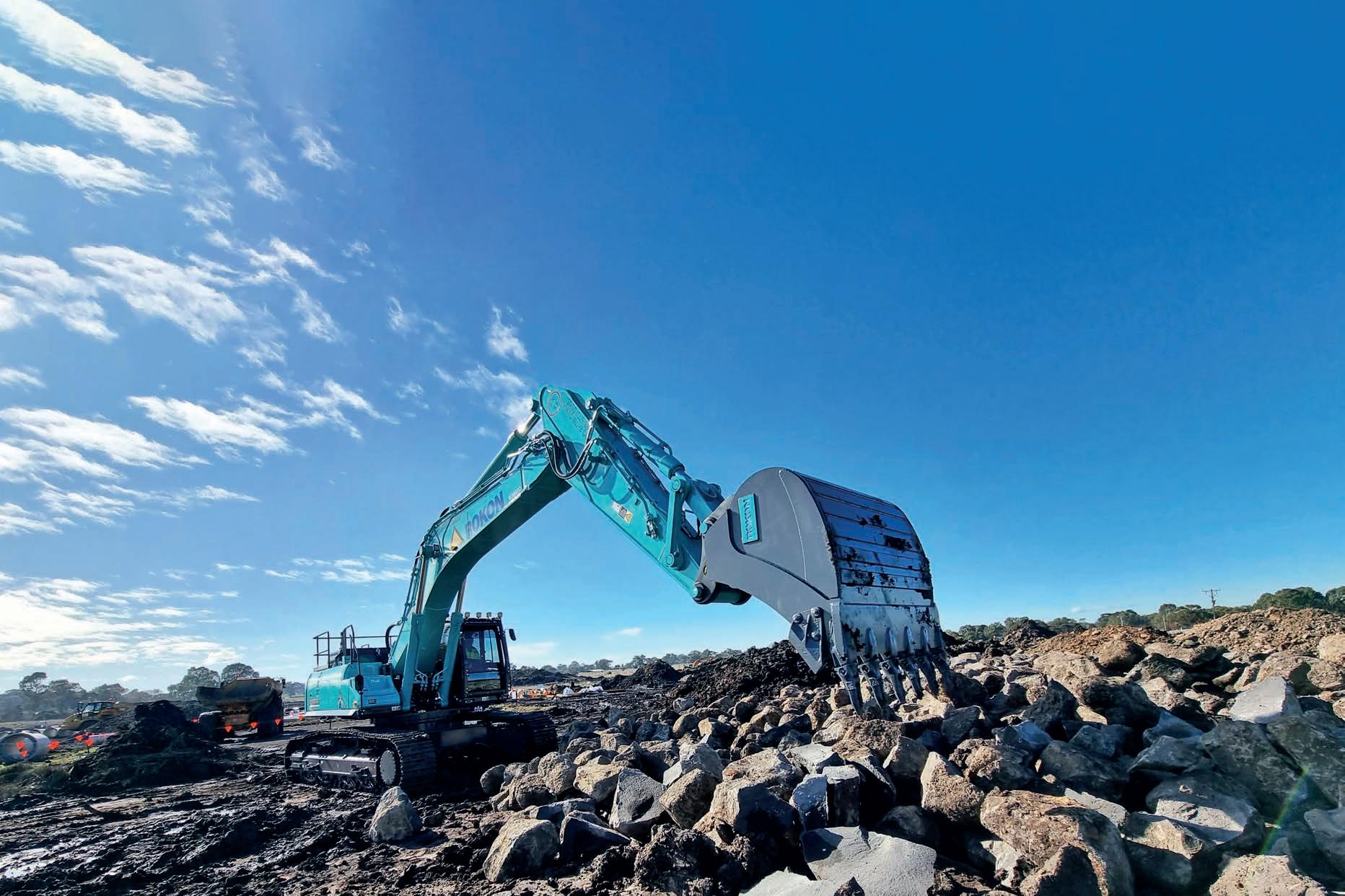
The recycled materials are then used for a range of applications. These include drainage and sewerage trench backfill, under footpaths and subgrade improvement on sites where the source rock has been extracted, minimising the use of road trucks, and lessening the use of diesel fuel which minimises the company’s carbon footprint.
Additionally, Rokon uses eco-friendly lubricants and conducts regular
maintenance checks on its plant, vehicles and equipment to ensure optimal performance and efficiency.
Rokon collaborates with developers who share its sustainability goals. This way, the company can achieve its sustainability objectives, help developers achieve their sustainability targets, and promote a more sustainable future.
Traicevski believes businesses can overcome the challenges of adopting sustainable practices by maximising existing relationships throughout the sector. He adds that Rokon is constantly exploring new ways to be more sustainable.
“We’re investing in research and development to find new and innovative solutions,” he says. “We seek to be at the forefront of environmental sustainability in
46 ROADS MAY 2023
ensures that asphalt is not put into landfill and reduces the need for bitumen content in recycled asphalt.


The aggregate is also utilised so the energy previously used in crushing the stone is not wasted. In addition, Rokon partners with quarries and recycling firms to provide paddock rock excavated in subdivisional road works, which is then crushed and used for road pavements and trenches. The company is also testing the use of biofuels with site generators to power all sites.
ROKON’S COMMITMENT TO THE FUTURE
Rokon’s commitment to sustainable practices is an example of how businesses can prioritise sustainability in their
enhance the capabilities of its workforce and provide opportunities for personal and professional growth.
Rokon’s commitment to sustainability demonstrates the positive impact of sustainable practices on the environment and the economy.
As businesses continue to acknowledge their impact on the environment and communities, it is crucial that they adopt sustainable practices to create a more sustainable future. Rokon’s dedication to sustainability not only benefits the environment but also enhances the quality and longevity of its projects, ensuring that its clients receive high-quality services that are environmentally responsible.
Furthermore, Rokon’s focus on collaboration with like-minded partners and suppliers who share its sustainability goals is essential to achieving a carbonneutral future. The challenges of adopting sustainable practices can be overcome by working together, exploring innovative solutions, and continuously improving and learning from experiences.

ENVIRONMENT & SUSTAINABILITY
Rokon’s focus on collaboration with like-minded partners and suppliers who share its sustainability goals is essential to achieving a carbon-neutral future.
Rokon has implemented a range of sustainability initiatives to minimise its impact on the environment.
Rokon is committed to sustainable procurement and project delivery.
A HYBRID OF INNOVATIONS
JOHN DEERE IS TAKING ON THE FUTURE OF SUSTAINABLE BUSINESS OUTCOMES BY HYBRIDISING SOME OF ITS TRADITIONAL MACHINES. WILL CROSS AND KAT ROBERTS OF JOHN DEERE DETAIL THE JOURNEY OF HYBRIDISATION AND WHAT IT MEANS FOR SUSTAINABILITY IN THE INDUSTRY.

Often linked to productivity and optimised fuel consumption, hybridisation can provide many benefits in machinery efficiency.

Hybrid-electric systems are designed to be more dependable, leading to greener and more sustainable outcomes for customers. Hybridisation, according to John Deere, is used to drive vehicle efficiency in two ways. Firstly, it utilises the engine’s power to generate electrical energy, powering various loads more effectively. Secondly, it assists in off-loading some of the engine’s energy demands with a battery as a second power source. It then uses that source to run other functions traditionally tied to the engine.
Will Cross, Supervisor for Electrification
Architecture and Systems Engineering, says electrifying vehicle systems is a necessary step towards utilising engine power more productively. He says the Construction and Forestry product lines are ideal examples of hybridisation.
“Our larger equipment will continue to have internal combustion engines for the foreseeable future due to energy density, so the question is how will we reduce carbon emissions for those systems,” Cross says.
“Reducing the carbon content of the fuel itself is one important path, but we can also think about how to make our power

48 ROADS MAY 2023
John Deere’s 944K loader and 850 dozer are some of the key machines that benefit from hybridisation.
Hybrid-electric vehicles are working toward a more sustainable construction industry.
generation and vehicle systems utilise fuel as efficiently as possible.
“The mechanical decoupling of loads from the engine, as well as inherent efficiency of electric drives, all contribute to improved vehicle productivity. This will continue to be fundamental to many of our products across the [John] Deere portfolio.”
John Deere’s largest wheel loader, the 944K, offers an alternative for quarry and aggregate applications, reflecting the benefits of hybridisation. Featuring a hybridelectric drive system designed to increase engine life and reduce fuel consumption, it combines both productivity and reliability.
With over a million operating hours in the field, the 944K loader offered an engineering and component foundation for future development that was tapped into with John Deere’s newest E-Drive offering, the 850 Dozer.
The 850 Dozer offers different modes, giving customers the choice of optimising productivity or fuel economy depending on the job.
Kat Roberts, Product Manager for Dozers and Crawler Loaders says the 850 Dozer can
be used in varying earthmoving applications including site development and roadbuilding.
“[John] Deere is still in the process of validation and testing, but we are seeing improvements in both fuel efficiency and productivity over traditional machines.”
MINIMISING IDLE TIME
John Deere is working to further improve productivity by adding a battery as a secondary energy source, to help minimise machine idle time.
Led by electrification advancements

and hybridisation opportunities, John Deere Power Systems (JDPS) is developing technologies to shut down the engine when minimal power is needed, while still providing power to loads such as cab heating and air conditioning.
Overall, according to John Deere,
this development helps deliver the benefits of burning less fuel, reduced greenhouse gas emissions, retained machine value, lower operating costs due to fuel and oil consumption, and reduced hour accumulation.
This also contributes to reduced regular maintenance and repair costs.
THE ROAD AHEAD
The progress of hybrid equipment is expected to not only provide near-term carbon and productivity benefits, but also
develop vehicle architectures to reduce alternative fuel usage and costs.
According to John Deere, the company will continue to aim for engineer systems that most effectively utilise engine power, providing both operating cost and productivity benefits to its customers.
ENVIRONMENT & SUSTAINABILITY
“REDUCING THE CARBON CONTENT OF THE FUEL ITSELF IS ONE IMPORTANT PATH, BUT WE CAN ALSO THINK ABOUT HOW TO MAKE OUR POWER GENERATION AND VEHICLE SYSTEMS UTILISE FUEL AS EFFICIENTLY AS POSSIBLE.”
EVENTS – INSIDE CONSTRUCTION EXPO
A PEEK INSIDE CONSTRUCTION EXPO
ROADS & INFRASTRUCTURE PROVIDES A SNEAK-PEEK INTO THIS YEAR’S INSIDE CONSTRUCTION EXPO.
As Australia continues its transition towards a more circular economy, industry leaders from the construction sector have been voicing the need for the increased use of recycled material in major infrastructure projects.
According to Show Director Lauren Winterbottom, the circular economy will be an area of focus for the event, which is slated for 20-21 September 2023 at the Melbourne Convention and Exhibition Centre.
“We are specifically looking to showcase companies that manufacture solutions for the construction industry out of recycled products,” she says. “We know this is a component of many major contract tenders now, and one that will only grow.”
Winterbottom says this push for sustainability in construction is central to the event’s ‘Engineering the Future’ theme – one that will revolve around a showcase for the achievements and opportunities presented by Victoria’s Big Build.
“Victoria’s Big Build program is ploughing ahead with speed,” Winterbottom says. “Inside Construction Expo will provide a platform to explore these projects, and a forum to connect equipment companies with the contractors who have won tenders to work on these major infrastructure projects.”
One such project, the construction of the Mordialloc Freeway in Melbourne’s south east, is often held up as an example of how the Recycled First Policy can be implemented effectively.
According to Victoria’s Big Build, the project was responsible for recycling 570 tonnes of plastic waste into noise walls; laid 75 tonnes of 100 per cent recycled plastic draining pipes; used more than 321 tonnes of sustainable roadbase and asphalt – including more than 202 million bottles worth of recycled glass; and diverted 97 per cent of its construction waste from landfill.
Elsewhere, groups are working tirelessly to
boost the uptake of end-of-life tyre-derived crumb rubber in road construction. Winterbottom hopes Inside Construction Expo can help play a part in showcasing the benefits of this push for circularity in construction, and keep the wheel of demand turning for recycled products.
“It’s important to us that the event is contributing to the future growth of the industry,” she says. “And it’s clear that in order for that to be the case, we need to ensure that companies providing these environmentally friendly solutions have a seat at the table.”
BACK ON SITE
In 2022 the construction industry faced its share of challenges – many of which could last through 2023 and beyond. Skilled labour shortages and supply chain disruptions caused by COVID-19 have forced the sector to adapt and evolve to keep pace with a booming national infrastructure pipeline.
Winterbottom says there is no better time for a new in-person event such as Inside Construction Expo, not only to provide a forum for discussion around these challenges, but to celebrate those who have overcome them.
“The past two and a half years have shown us that people value in-person events more than ever,” she says. “While virtual events helped to fill the void, they just can’t compare to a face-to-face networking opportunity.


“Inside Construction Expo will provide a forum to address some of the big challenges facing the construction and infrastructure industry, and to help ensure that the future of the sector is strong.”

The two-day event will feature more than 100 speakers across four streams, an awards gala, and more than 15,000 square metres of exhibition space, including a large construction equipment showcase – one Winterbottom hopes will turn some heads.
“We want to do everything we can to help connect our exhibitors with their target customers,” she says. “We’re always thrilled when exhibitors tell us they’ve sold a piece of equipment or signed a new supply contract as a result of their participation in an expo. It reinforces that we’re bringing value back to the industry, and helping it to grow.”
For more information, visit: www.insideconstructionexpo.com.au
50 ROADS MAY 2023
2023
The 2023 Inside Construction Expo will be held at the Melbourne Exhibition Centre on September 20-21.
JOIN US TO CELEBRATE THE BEST OF THE BEST FROM ACROSS THE AUSTRALIAN INDUSTRIALS SECTOR

Celebrate the women who work tirelessly to advance the mining, engineering, road transport, logistics, rail, bulk handling, infrastructure and waste management industries.


TICKETS ARE NOW ON SALE



PROUDLY PRESENTED BY
MHD upply
THURS 8 JUNE 2023 SPONSORED BY Australia
WOMENININDUSTRY.COM.AU/AWARDS
Sept 2023
Melbourne’s leading construction and major infrastructure event


EXHIBITION
SPACE NOW ON SALE
Inside Construction Expo will deliver



Targeted messaging in over 19 industry-leading publications that reach more than 80,000 decision makers across multiple sectors

Digital communications to 28,000+ engaged readers


Premium networking opportunity with industry leaders at the Foundation Awards gala dinner

insideconstructionexpo.com.au
 Melbourne Convention and Exhibition Centre
Melbourne Convention and Exhibition Centre
20-21
CONFERENCE SPONSOR ASSOCIATION PARTNERS SUPPORTING SPONSOR
ROAD SAFETY
AUSTRALIAN FLEXIBLE PAVEMENT ASSOCIATION EXECUTIVE DIRECTORQUEENSLAND AND THE NORTHERN TERRITORY, MARK PIORKOWSKI, PROVIDES AN OVERVIEW OF A NEW TRAFFIC CAMERA PILOT PROGRAM AIMED AT REDUCING SPEEDING IN WORK ZONES.

and roadworks, which both feature a high number of vulnerable road users and reduced roadside space for deployment of existing mobile speed cameras or road safety camera trailers.
To address this issue, the Department of Transport and Main Roads (TMR) has been working with vendor Hyperion Technology to deliver the Roadways Behaviour Monitoring System (RBMS), a two year pilot program of a world first technology to address speeding at roadworks and school zones.
Queensland Transport and Main Roads Minister Mark Bailey has been a driving force behind getting this technology operational.
“I don’t want to see another roadworker killed or someone’s child badly injured on their way to school just because of the recklessness of a
speeding driver,” Bailey says.
The RBMS uses lightweight speed camera technology mounted to a platform which resembles existing flashing school zone or can be deployed in a roadwork site. The system is solar powered with lithium batteries for backup and is capable of deploying in a much smaller footprint than existing speed camera solutions.
In addition to speed enforcement capability, the RBMS will feature Machine Vision cameras which track all units moving through the area, providing valuable data and statistics.
The first systems were deployed by late 2022 for trials in collaboration with industry through the creation of a working group by TMR with AfPA (the Australian Flexible Pavement Association) and industry members to inform

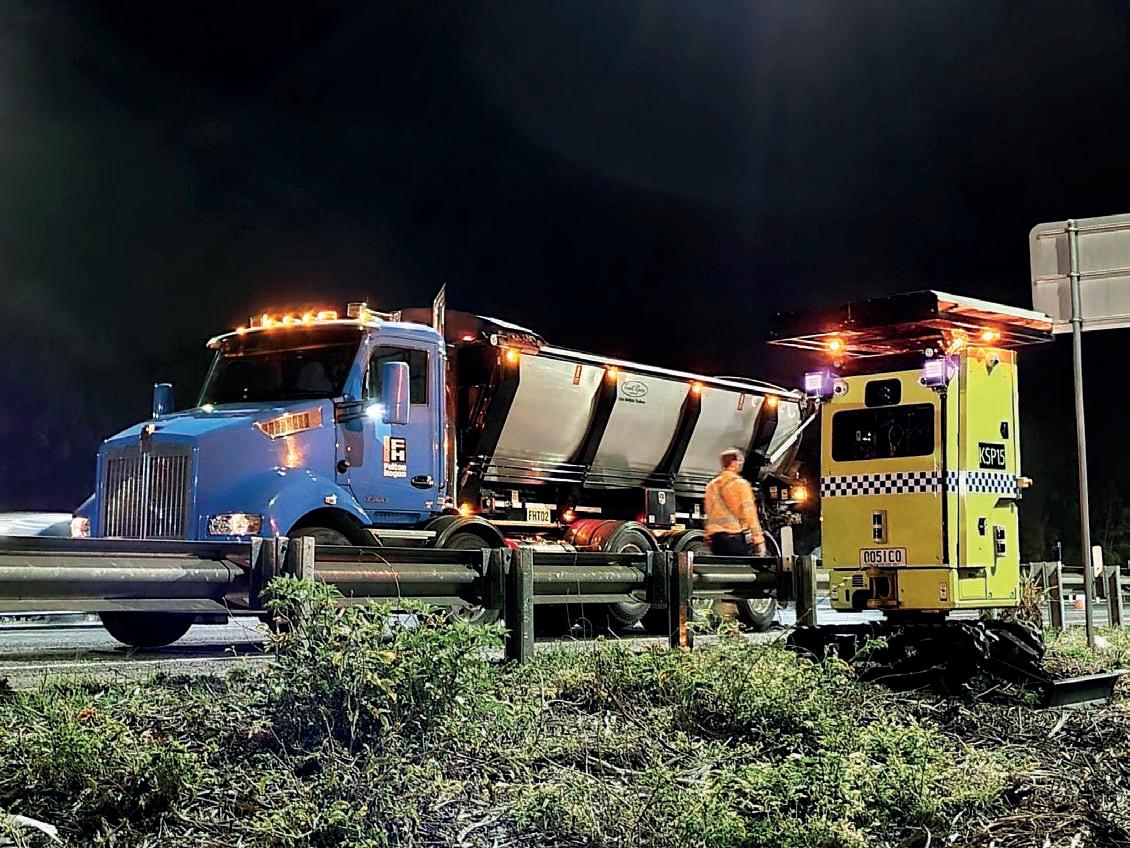
roadsonline.com.au 53 TRANSFORMING
Queensland TMR has worked with government and industry to develop a new technology, designed to target speeding drivers.
system at a range of roadworks. While the design and procurement process had been lengthy, the resulting preferred technology has exceeded expectations for industry members involved in the recent trials.
Participation in trials on live worksites over the last six months was enabled through a working group developed by TMR which included AfPA and other industry members to inform locations for roadworks deployment.
high and has contributed to the successful development of the pilot by advising for amendments to TMR’s MRTS02 document to allow for more streamlined requests of speed enforcement at shorter term sites.
Within the Southeast Queensland region, the RBMS was deployed on the Pacific Motorway in late November 2022. This deployment was very successful with the contractor (Fulton Hogan) noting on job logs the
in the motorist behaviour especially seen in the morning where motorists were seen adhering to the 80km/hr speed requirements. Given the mobility of the camera it was able to move with the work crews as they progressed the profiling and asphalt works.
Moving forward as the trial is concluded TMR has continued with industry focussed working group meetings for consideration of site selections and other matters associated with the project to identify where improvements could be made on siting the camera, associated signage and lighting.
In the case of live trials at roadworks the mobile speed camera has been deployed in on a Smart Tracked Platform in the roadworks zones. The system is manoeuvrable on site by remote control and can be delivered on the back of a flat bad truck. The cameras were specifically designed for this purpose and built to sit on top of a mobile platform that can easily be manoeuvred to different locations around a worksite. Due to smaller footprint and solar panel power supply, the device can deploy in locations
improvement in speed compliance through the site. The solution is currently undergoing final testing for reliability of speed measurement. Further deployments are expected in April 2023.
Feedback from crews working on the trial worksites during the camera deployment has been very positive. During the deployment of the camera motorists were noted to have immediately started to slow down with the presence of the camera noted to
Throughout the life of the project –including the trials – it should also be noted that the Department has also maintained close engagement with the Queensland Police Service to ensure that the camera also meets their requirements. Operational deployment of the cameras is expected by mid-year.
The RBMS is a ground-breaking program that could revolutionize road safety, not just in Queensland but around the world. By combining innovative technology with targeted deployment, this program has the potential to significantly reduce speed-related fatalities and injuries on the nation’s roads.
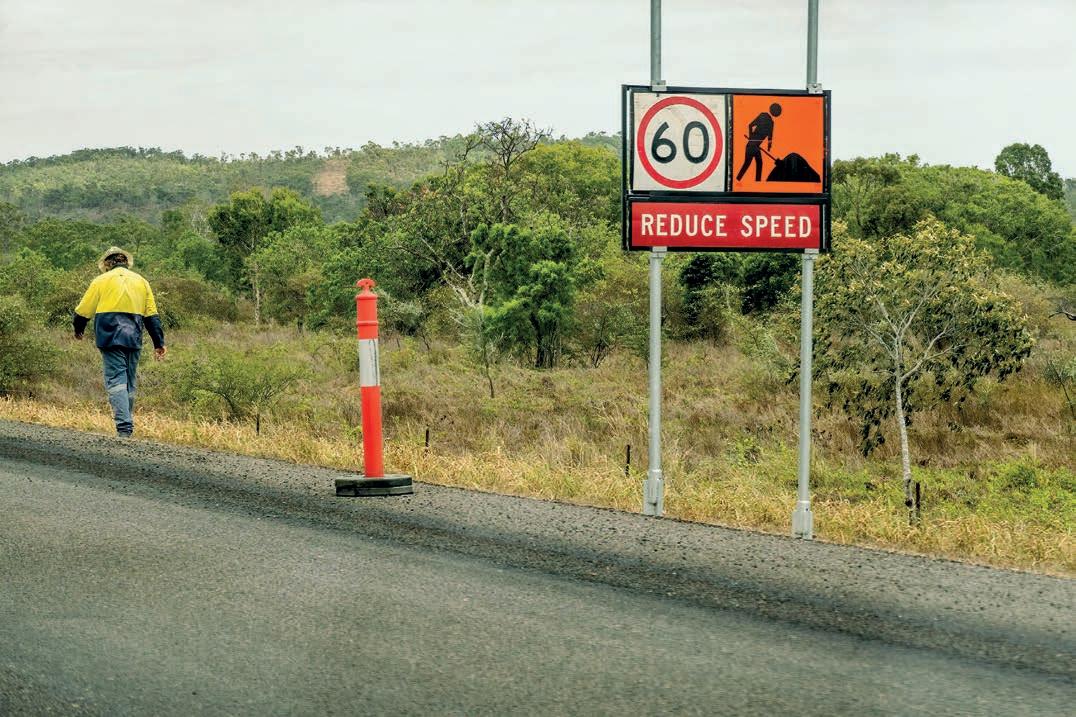
54 ROADS MAY 2023
In Queensland, speeding was responsible for 27.1 per cent of road fatalities in 2021.
“GIVEN THE MOBILITY OF THE CAMERA IT WAS ABLE TO MOVE WITH THE WORK CREWS AS THEY PROGRESSED THE PROFILING AND ASPHALT WORKS.”

AUSTRALIAN FLEXIBLE PAVEMENT ASSOCIATION 2023 Industry Awards Nominations Open https://www.afpa.asn.au/2023-industry-awards-nominations/ 2023 State Industry Awards Series & Dinner Sponsors Limited Award and Dinner Sponsorship opportunities are still available https://bit.ly/3U588zL
SUPPORTING THE NEXT GENERATION OF LEADERS
Delivering social, cultural, environmental and economic benefits. That is the aim of the Infrastructure Sustainability Council (ISCouncil).
As part of this ethos, the ISCouncil’s 2020-2025 strategic plan includes a focus on creating a ‘thriving industry’, by supporting the industry to be connected, collaborative and ambitious.
As part of this focus, the ISCouncil is exploring new ways of driving best practice and being an advocate for change, in an industry that is still working to embrace sustainable methods and processes. The organisation’s new ‘Rise’ Leadership Mentoring Program is a reflection of this. The program aims to bring together experienced and young industry representatives in order to establish a collaborative and creative environment.
ISCouncil CEO Ainsley Simpson says the program – which was run for the first time in 2022 – closely aligns with the organisation’s ambitions.

“At the heart of infrastructure, the purpose is to deliver services to beneficiaries,” Simpson says. “It’s infrastructure for the people, by the people.
“For some time now, we’ve recognised that the future depends on the next generation of sustainability professionals. These leaders have an inherent culture of courage. They understand the importance of initiative and agility and they’re in environments where they have a lot of agency, without any authority.
“These people not only have the technical depth, but they can also be influencers. It was important for us to connect these people with the leaders we have today, in order to build our strengths for the future.”
The ‘Rise’ Leadership Mentoring Program aims to bring together young leaders in the sustainable infrastructure space with established individuals to collaborate and
innovate in a number of different aspects.
BENEFITS FOR ALL
By matching emerging leaders across the industry with experienced representatives across the industry, Simpson says the ISCouncil hopes to foster impactful idea generation, as well as the establishment of meaningful interpersonal relationships.

Each participant is matched up through a third-party provider that specialises in mentoring programs. The Art of Mentoring utilises an algorithm to dictate the mentee and mentor selections, based off the desires and needs of each participant, as Simpson explains.
“Before the program begins, we ask participants what skill sets they’d like to develop, as well as some of the challenges that they’re facing in their workplace. We also ask mentors about their strengths and what they can bring to the program,” she says. “It helps to make sure that everybody’s needs and desires can be matched.
“It creates a safe space for these types of conversations to build up our executive bench strength. That’s the purpose of the program, to establish a program which is about leading sustainably today and tomorrow.”
While the mentors and mentees predominantly work in the infrastructure space, there’s a diverse range of career backgrounds and passions. Simpson says the diversity of the participants further enriches the program.
“Our mentors come from a variety of different professional backgrounds and subsectors of the industry. Some of these are vastly different backgrounds and not everyone has deep sustainability backgrounds, but all of them have the passion and commitment,” she says.
“The brilliance behind this program is that
“It’s really exciting that we are engaging an audience across our entire value chain.”
Simpson says she has witnessed firsthand the impact of mentoring, with mentors playing an important role in the development and continued success of her career.
“Every person has different ‘seasons’ in their careers and you can experience different kinds of challenges. You need to grow in different ways, so throughout my career I’ve formally and informally sought out people who can help me,” she says.
“The best thing that we can do is to show up and be the best version of ourselves and be better than we were the day before. To achieve this, it’s very valuable to learn from other people’s experiences.
“When you find great mentors, you often evolve to be great friends.”
She adds that the program provides “meaningful benefits” for the mentors as well.
“The feedback that we got from mentors was how valuable it was to give back to the industry; how much they learned and how
56 ROADS MAY 2023
THE INFRASTRUCTURE SUSTAINABILITY COUNCIL HAS DEVELOPED A NEW PROGRAM AIMED AT IDENTIFYING AND DEVELOPING THE NEXT GENERATION OF LEADERS IN SUSTAINABILITY.
Infrastructure Sustainability Council
Infrastructure Sustainability Council CEO Ainsley Simpson.
they connected with younger professionals who are striving to be the next generation of leaders,” Simpson says.
“Sustainability is a team sport, it’s not something that any one individual can achieve on their own. That’s why collaboration and participation are so important. Everybody needs to understand their role in delivering sustainable outcomes,” Simpson says.
A BRIGHT FUTURE
The first program in 2022 has been considered as a success, with more than 80 per cent of the participants saying it had a positive impact on their career advancement, as well as a positive impact on their sense of wellbeing. For the mentors, over 90 per cent said their participation had a positive impact on their personal learning and growth. For the mentees, 90 per cent said they had acquired new skills through their participation.
“Feedback from the first round of the program was that it was a genuine mutual exchange of information and learning,” Simpson says.
Casey Doolan, Sustainability Advisor, ARTC was one of the many mentees who
participated in the 2022 program. She says she’s “extremely grateful” to have had the opportunity to be involved.
“My experienced mentor has helped me to recognise the possibilities of a career in sustainability, expand my professional network and step outside my comfort zone,” Doolan says.
“I hope to become a mentor myself one day and I look forward to inspiring, challenging and encouraging the next generation of IS professionals.”
Rod Barber, Director Environment and Sustainability (Rial Operations), Transport for NSW, says mentoring at the event provided a valuable experience.
“I decided to become a mentor as I would like to be able to pass on the benefit of the experience that I have gained in how to build environment and sustainability into business practices and helping it to be seen as part of doing business rather than as an add on or an extra burden,” Barber said.
“Out of the program, I’m hoping to gain an insight into the industry from the perspective of people who are starting out, as well as what new approaches and ideas have they
learnt from university and starting work. It’s important to never stop learning.”
Seven mentors from the 2022 cohort have already expressed their interest in mentoring again in the 2023 program. Two mentees from the program last year have also expressed interest in being mentors for the 2023 program, after reaching leadership roles in their organisations.
Simpson says the ISCouncil is also developing additional programs, aimed at encouraging greater female representation amongst sustainable leaders and innovators.
“One of our future ambitions is establish a ‘Rise’ cohort that is specifically for women, focused on making sure there’s increasing number of women in leadership positions from infrastructure backgrounds, who are inherently connected to sustainable outcomes,” Simpson says.
The 2023 program, sponsored by Gamuda Australia will commence on May 16, and applications have recently closed, but Simpson says those interested in being a mentor or mentee as part of future programs can express their interest by visiting: https://rise.aomapp.net/

roadsonline.com.au 57
The Rise Mentoring program pairs experienced sustainability professionals with emerging industry leaders.
CONTRACTS IN BRIEF
THE AUSTRALIAN INFRASTRUCTURE SECTOR.
VICTORIA
Joint venture awarded $700M pipeline contract
A joint venture consisting of BMD Constructions and McConnell Dowell has been awarded a $714 million contract to deliver the Fitzroy to Gladstone Pipeline project in Queensland. The design and construct contract, awarded by the Gladstone Area Water Board and Queensland Government, will see the JV deliver a 117 kilometre pipeline, a water treatment plant, reservoirs and pumping stations. The project will provide further water security for the area and support for the emerging hydrogen industry in the Gladstone region in Queensland, Australia. It’s also expected to secure the single source water supply risk from Awoonga Dam, enabling long-term water security for urban and industrial customers in the region. The winning bid for the contract included the employment of a diverse workforce including a $10 million commitment to suppliers and businesses owned by First Nations Australians, 10,000 hours for Aboriginal and Torres Strait Islander workforce participation, as well as trainees and apprentices to make up 15 per cent of the workforce hours. Major construction on the project will start later this year, with the pipeline expected to be completed in 2026.
Design consultant appointed for $150M Commonwealth Games upgrades
Cox Architecture and Morton + Co
Architects have been appointed as the design consultant team for works on the $150 million upgrade to Eureka Stadium, in the lead up to the 2026 Commonwealth Games in Victoria. From 17 to 29 March 2026, Geelong, Bendigo, Ballarat, Gippsland and Shepparton will host 20 sports and nine fully integrated Para sports. For the Games an additional 18,000 temporary seats will be installed as well as a competition standard track on the existing playing field. A new athletics track will be built at the site and the stadium will be expanded to hold an additional 5000 permanent seats, with improved accessibility access. Eureka Stadium will host Athletics and Para
Athletics, Ballarat’s sports program will also include the Marathon and Boxing. Cox Architecture will partner with Ballarat firm Morton + Co Architects to lead the project from the concept design phase through to detailed design and construction. It is estimated the Commonwealth Games will contribute more than $3 billion to Victoria’s economy and create more than 7500 jobs before, during and after the Games.
UGL receives Melbourne train contract extension
CIMIC’s UGL’s contract with Metro Trains Melbourne has been extended which will see the company operate the city’s metropolitan passenger rail service for an additional 18 months. Before the extension, the contract initially was for a seven-year agreement from November 2017 to November 2024. The contract extension, awarded by the Victorian State Government, will begin in November 2024. As part of the MTM (Metro Trains Melbourne) consortium, UGL has operated passenger trains in metropolitan Melbourne since 2009. MTM comprises MTR Corporation (60 per cent), John Holland (20 per cent) and UGL (20 per cent). Excluding the extension, the current contract will generate around $1.8 billion for UGL. Metro Trains Melbourne Metro operates 226 six carriage trains across 998 kilometres of track, transporting 450,000 customers each day.
WESTERN AUSTRALIA
Alliance contract finalised for Fitzroy River Bridge
Contracts have been finalised for an alliance comprising Georgiou Group, BMD Constructions, and BG&E to construct the new Fitzroy River Bridge in Western Australia. The Fitzroy River Bridge was hit by Tropical Cyclone Ellie in late December 2022, causing significant damage to the structure which now requires major works. These repairs are set to begin in May 2023. The Fitzroy River Bridge Replacement will include the construction of a two-lane bridge over
the Fitzroy River, provision of a pedestrian pathway, bridge approaches to connect the new bridge to the existing great Northern Freeway and modification of utility services required for the construction of the works. The three companies will form the Fitzroy Bridge Alliance along with WA Main Roads. Designs for the new bridge are progressing, with site works on track to begin in April, subject to weather and the resolution of environmental and heritage issues. Work on constructing the first of two new low-level crossings is underway. The crossing, which is adjacent to the old Fitzroy River Crossing, now allows four-wheel-drive vehicle access across the river and opened in early April. A second, low-level, two-lane crossing 150 metres upstream of the old bridge, which would cater for higher traffic volumes, including freight vehicles and pedestrians, could provide access across the river during this year’s dry season. The Fitzroy Bridge building works are funded through the Commonwealth-State Disaster Recovery Funding Arrangements. The new bridge is scheduled to be operational by mid-2024.
CPB awarded $105M Mt Keith Contract
CPB Contractors has been awarded a contract for $105 million works on the Mt Keith Debottlenecking Project in Western Australia. As part of the contract, CPB Contractors will deliver the Structural, Mechanical, Piping, Electrical & Instrumentation (SMPE&I) work package near Leinster. The BHP Nickel West Mt Keith Debottlenecking Project will provide additional grinding capacity to meet the processing requirements of ore with different characteristics. BHP have also selected CPB Contractors for a variety of works in Western Australia, including construction and installation works at Port Hedland. Works at Mt Keith will commence this year and are scheduled for completion in 2024.

58 ROADS MAY 2023 CONTRACTS & TENDERS
ROADS & INFRASTRUCTURE PROVIDES AN UPDATE ON SOME OF THE CONTRACTS AND TENDERS RECENTLY AWARDED OR PUT TO MARKET ACROSS
INNOVATIVE SOLUTIONS FOR PORTABLE ENERGY
Built to withstand a variety of conditions the Atlas Copco range of lighting towers are robust and offer unrivalled efficiencies ensuring they are both reliable and can operate for an extensive period of time.


• Fuel efficient, ensuring longer running hours
• Specially designed directional optics offering incredible light distribution
• LED HiLight towers achieve up to 6.000 square-metres of light coverage with an average level of 20 luxes
• A life expectancy of more than 50.000 hours

• Aluminium casting, providing heavy duty protection
Small Asphalt Rollers Compact
and Smart
DYNAPACS SIXTH GENERATION SMALL ASPHALT ROLLERS - READY TO ROLL


Dynapac’s sixth generation CC1300VI and CC1400VI small asphalt rollers are designed and built to meet the construction industries ever evolving and tough conditions. The new design has resulted in a robust, comfortable and modern machine that still achieves the market leading compaction results that Dynapac is renowned for.
The new generation has a unique cross mounted engine providing exceptional access to engine and hydraulic components. This new engine concept and the slideable operators seat combine to increase visibility to drum edges and the greater worksite. High vibration frequency, offsetability of the drum, high efficiency eccentrics and options such as edge press devices and chip spreaders all improve compaction efficiency and versatility.
SPEAK TO OUR TEAM TODAY FOR AVAILABLE FINANCE OPTIONS!
782 www.atlascea.com.au
PH: 1800 733
Your Partner on the Road Ahead PROUD DISTRIBUTOR
dynapaccea.com.au 1300 788 757

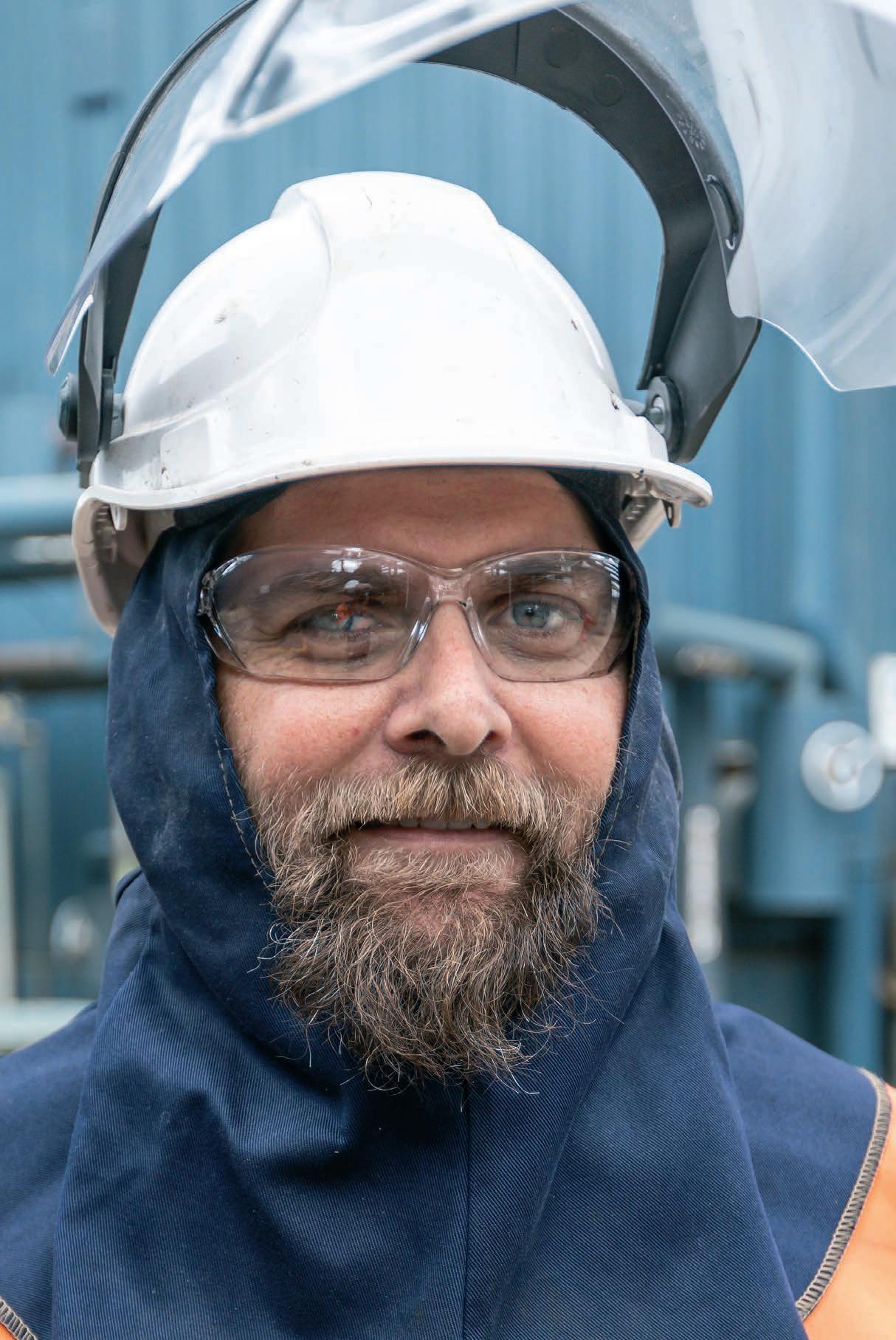


































































































































































 Lintec CDP mobile continuous asphalt mixing plant
Linnhoff TSD MobileMix asphalt mixing plant Lintec CSM containerised asphalt mixing plant Eurotec Eco concrete batching plant
Lintec CDP mobile continuous asphalt mixing plant
Linnhoff TSD MobileMix asphalt mixing plant Lintec CSM containerised asphalt mixing plant Eurotec Eco concrete batching plant



































 Melbourne Convention and Exhibition Centre
Melbourne Convention and Exhibition Centre









